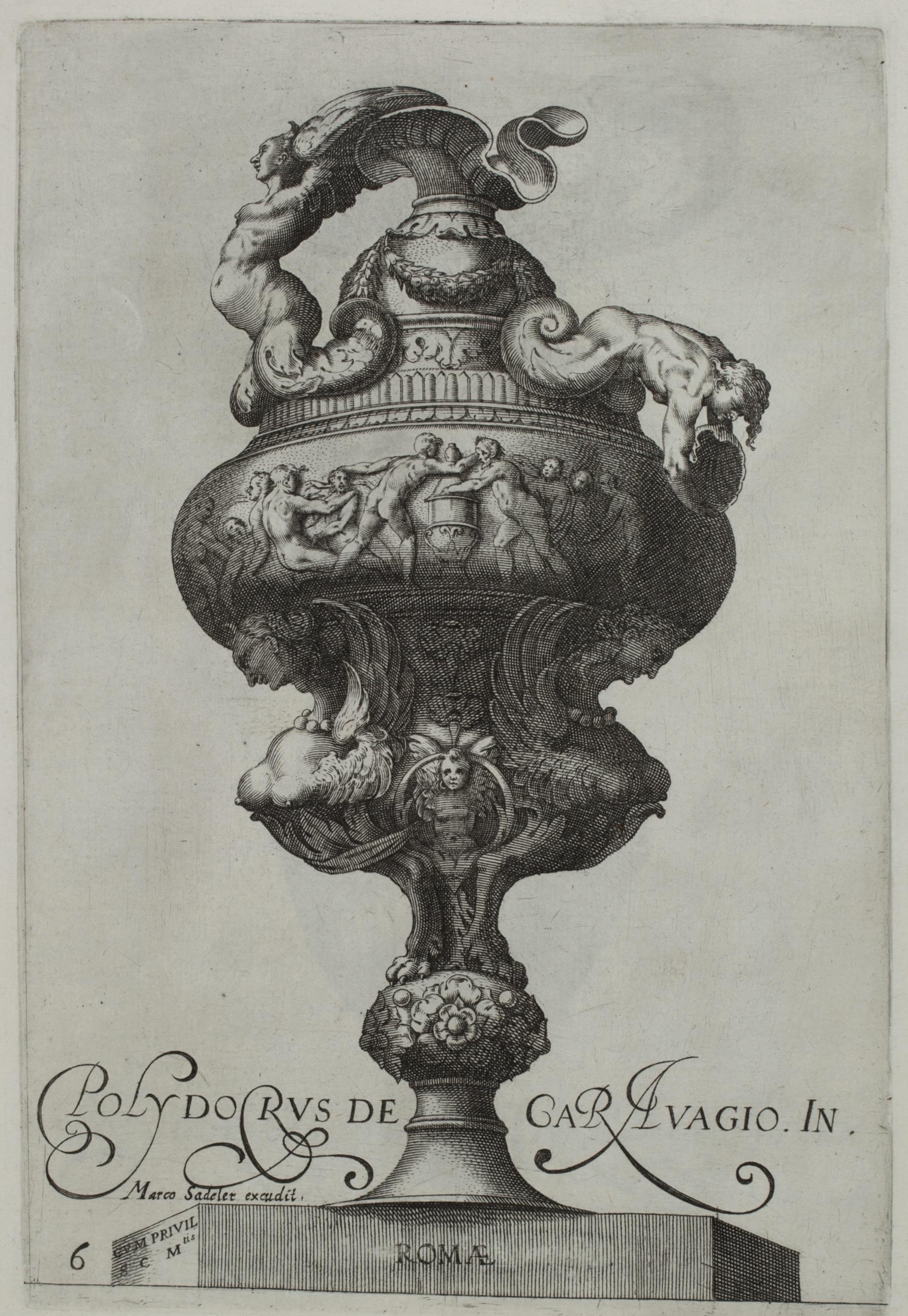

MMXXII
SARAH SAUVIN ‘‘Recueil de Vases’’ 45 series of prints gathered by Hippolyte Destailleur

Collection of 45 series of prints depicting vases gathered by
Hippolyte Destailleur
Important set of 45 series containing 325 plates bound by Hippolyte Destailleur (1822 1893) in 4 volumes in 4 (marbled calf, spine decorated between the raised bands with a special tool with a vase motif, red and black morocco lettering and numeration pieces, two double gilt fillets on covers, red edges, marbled endpapers. Binding of the 19th century).
Volume 1: 15 series, 101 plates
Volume 2: 7 series, 53 plates
Volume 3: 13 series, 93 plates
Volume 4: 10 series, 78 plates We distinguished in particular four important and rare series: a series of 12 vases by René BOYVIN (or Pierre MILAN) after Rosso FIORENTINO, Polidoro DA CARAVAGGIO and Léonard THIRY a series of 10 vases and 4 knives by Aegidius SADELER II after Polidoro DA CARAVAGGIO and Francesco SALVIATI, a series of 6 vases by Claude Henri WATELET after Jean Baptiste Marie PIERRE, a set of 37 subjects of vases, tombs, ruins and fountains by Jean-Laurent LEGEAY
The other series bound in the four volumes are engraved by: Adélaïde ALLOU, Jean Jacques AVRIL
AVRIL
BOUCHER
COUTURE,
F.
Jacques
MOITHEY
Louis PRIEUR, RAUX. Some of these series are very rare. The flyleaves of each volume bear annotations in pencil briefly describing the contents. The plates are numbered in pencil, generally in the upper right corner of the support sheet or of the print. They are either directly bound or mounted à claire voie (openwork) on bound leaves. The plates are generally in very good condition. Some minimal soiling. Some rare defects. Binding in very good general condition: some rubbing and beginning of splitting at two spines. These four volumes correspond exactly to the description of the thematic collections constituted by Hippolyte Destailleur presented in the Lugt 740 entry (revised in December 2020): "Destailleur had the particularity to constitute thematic albums of his prints and drawings. The drawings as well as the prints were mounted or re-mounted to unify the format, and bound. Destailleur would write a commentary on the title page, often accompanied by a mention of the number of works contained
known as
the elder, Stefano della BELLA, Juste Nathan François
known as BOUCHER fils,
BRARD, C. BRESSE, Charles Nicolas COCHIN I, Joseph Abel
called COUTURE the elder,
DAMERY, Charles DUPUIS, Jean HOUDAN, Gabriel HUQUIER, Charles François JOLY, Jacques JUILLET, Jean LEPAUTRE, MANIERE, Pierre de MASSART called ROCHEFORT,
the elder, P. NICOLET, Jean
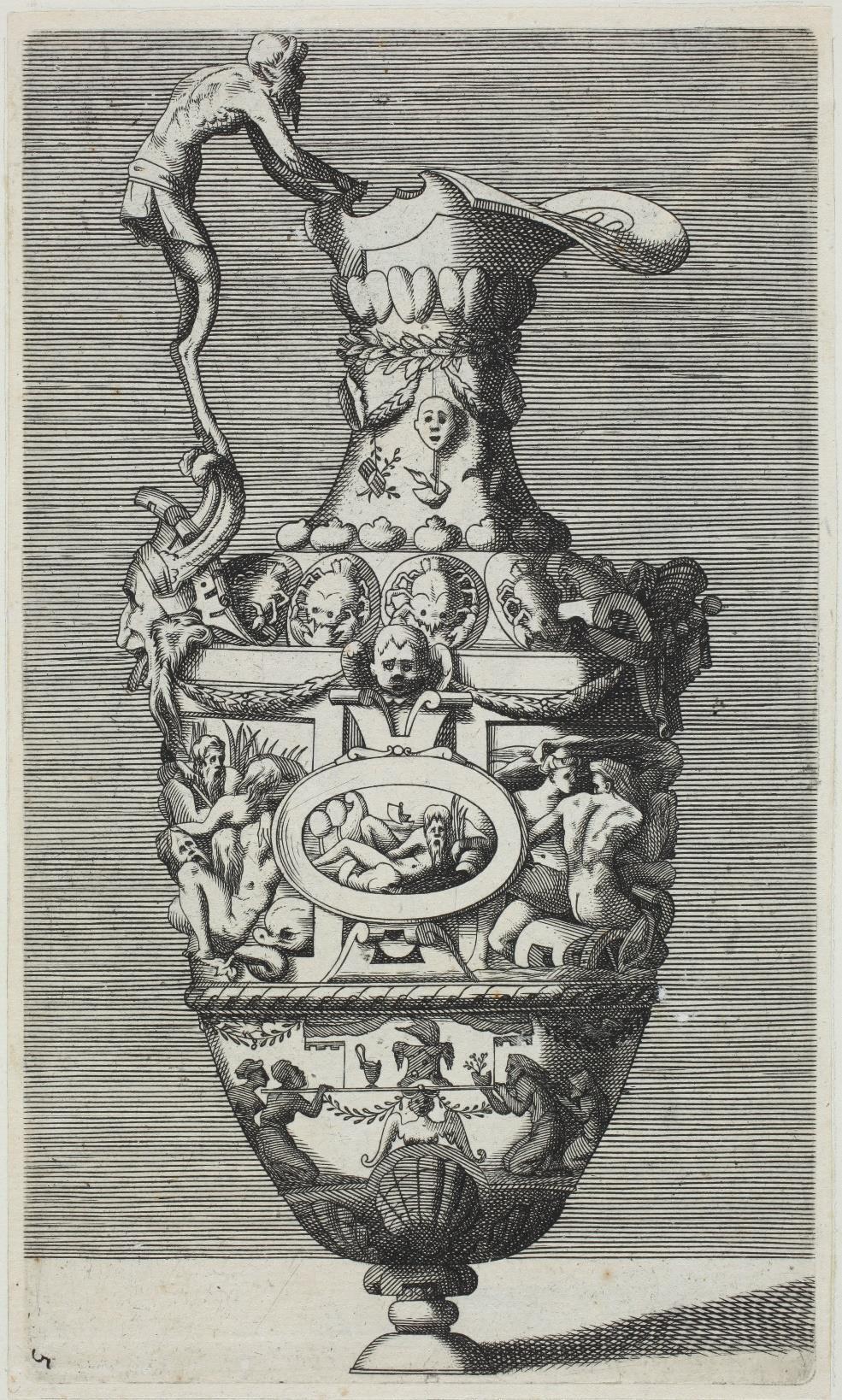

in the album, which he followed with his initials (see L.1303a and b). We have never encountered these initials alone. Destailleur also used to number the works in graphite in the upper right hand margin and, sometimes, to add a title or an artist's name in the lower middle. This way of doing things undoubtedly allowed him to reappropriate his collection in a methodical way. At the same time, these annotations testify to his great erudition, which is also reflected in a whole series of publications. The fact that the drawings and prints were inserted in bindings allowed him to store them in his extensive library in the form of volumes. This is what many collectors of his generation did, such as André Denis Bérard (see L.75) and Alfred Beurdeley (see L.421), or other collectors before them. Today the prints and drawings of several public collections remain partly preserved in volumes (as is the case in Dresden, Paris, St. Petersburg or Vienna)." (our translation).
Hippolyte Alexandre Gabriel Walter Destailleur (1822 1893) a French collector, bibliophile and art historian was an internationally renowned architect. "He built, decorated or restored a number of monuments, castles, private mansions, among which, in Paris, the hotels of Haussonville, Pourtalès, Behague, Noailles, Luynes, Cahen d'Anvers, etc., in the provinces, the castles of Mouchy, Mello, Maintenon, Franconville, etc., and abroad the castle of Plesse (Upper Silesia), the hotel of the prince of Pless in Berlin, that of baron A. de Rothschild in Vienna, the castle of Waddesdon (England) for baron F. de Rothschild, the Medinaceli palace in Madrid, etc." (Lugt 740, our translation)


Hippolyte Destailleur had built up a very important collection of architectural, decorative and ornamental drawings and prints which he used as documentation.
After having sold the major part of a first collection to the German State in 1879, he constituted a second collection, part of which was sold at auction in several parts:
- in 1890: prints of the French school of the 18th century (1399 lots) and drawings (210 lots), historical pieces and scenes of manners (284 lots), modern prints (42 lots), i.e. 1935 lots; in 1891: rare and precious books; in 1893: original drawings collected in collections, 125 lots; in 1894: books and prints relating to the history of Paris and its surroundings, 585 lots; in 1895: books and prints relating to the fine arts, 1753 lots; in 1896: original drawings and paintings, 908 lots; finally, in 1901: drawings and paintings, 203 lots.
Works from Hippolyte Destailleur's collection are today kept in numerous public and private collections. The Bibliothèque nationale de France holds a collection of drawings and prints on the theater as well as an important set of drawings relating to the city of Paris and the French departments.
The Lugt 740 entry indicates that "at the sale of May 20 31, 1895, the firm of Frederik Muller, bidding at the request of the Rijksprentenkabinet of Amsterdam and at the suggestion of the Dutch collector J.A. Frederiks (see L.5007), purchased several rare sixteenth and seventeenth century ornamental prints (see E. Korthals Altes, 'Johan Philip van der Kellen
(1831 1906), de eerste directeur van het Rijksprentenkabinet', Bulletin van het Rijksmuseum, 46, 1998, 2 3, pp. 207 263, p. 237 and note 176; P. Fuhring, Ornament Prints in the Rijksmuseum. II. Seventeenth Century, Amsterdam Rotterdam 2004, vol. 1, p. 31)." (our translation).


The four volumes of the Collection of Vases also come from this 1895 sale. They are listed in the catalog under number 563 :

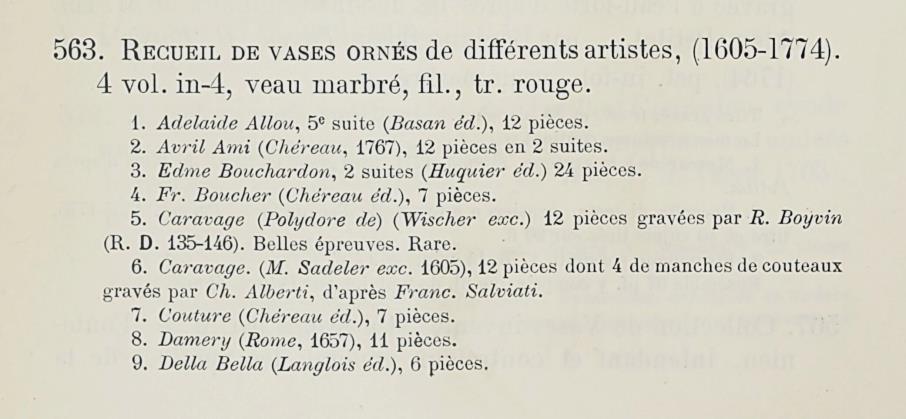
DESCRIPTIONS
OF FOUR SERIES
René BOYVIN (ca. 1525 - 1598 or 1625/6) or Pierre MILAN (active ca. 1542-1557)
Twelve vases
Complete series of 12 plates, published by Claes Jansz. Visscher (1587 1652).
Engraving, 190 x 112 mm Robert Dumesnil 135 146, Levron 255 266. Veryfineimpressionsprinted onlaid paper (watermarkGothic P). Generally, in very good condition. One 20 mm tear on a plate.
Peter Fuhring details the four currently known editions of this series as follows: I. French edition before numbering; II. French edition with numbered plates; III. Amsterdam edition, with numbered plates and inscribed on the first print Polidoro inventor/ JCVisscher excudebat; IV. Second Amsterdam edition with F. de Widt excudebat. (Peter Fuhring, p. 332, note no. 590). The attribution of the engravings on the one hand and of the compositions from which they are inspired or which they reproduce on the other is not easy.
Jacques Levron, in his catalogue raisonné of René Boyvin's prints, classifies this series among prints from Boyvin's studio because they do not bear his signature, but specifies: "Generally speaking, one finds in all the drawings of goldsmithery from the Boyvin studio (three series are known) details that clearly recall the artist's style. They are not signed, but it is almost certain that he is the author. However, students may have retouched them. (Levron, p. 78). Robert Dumesnil
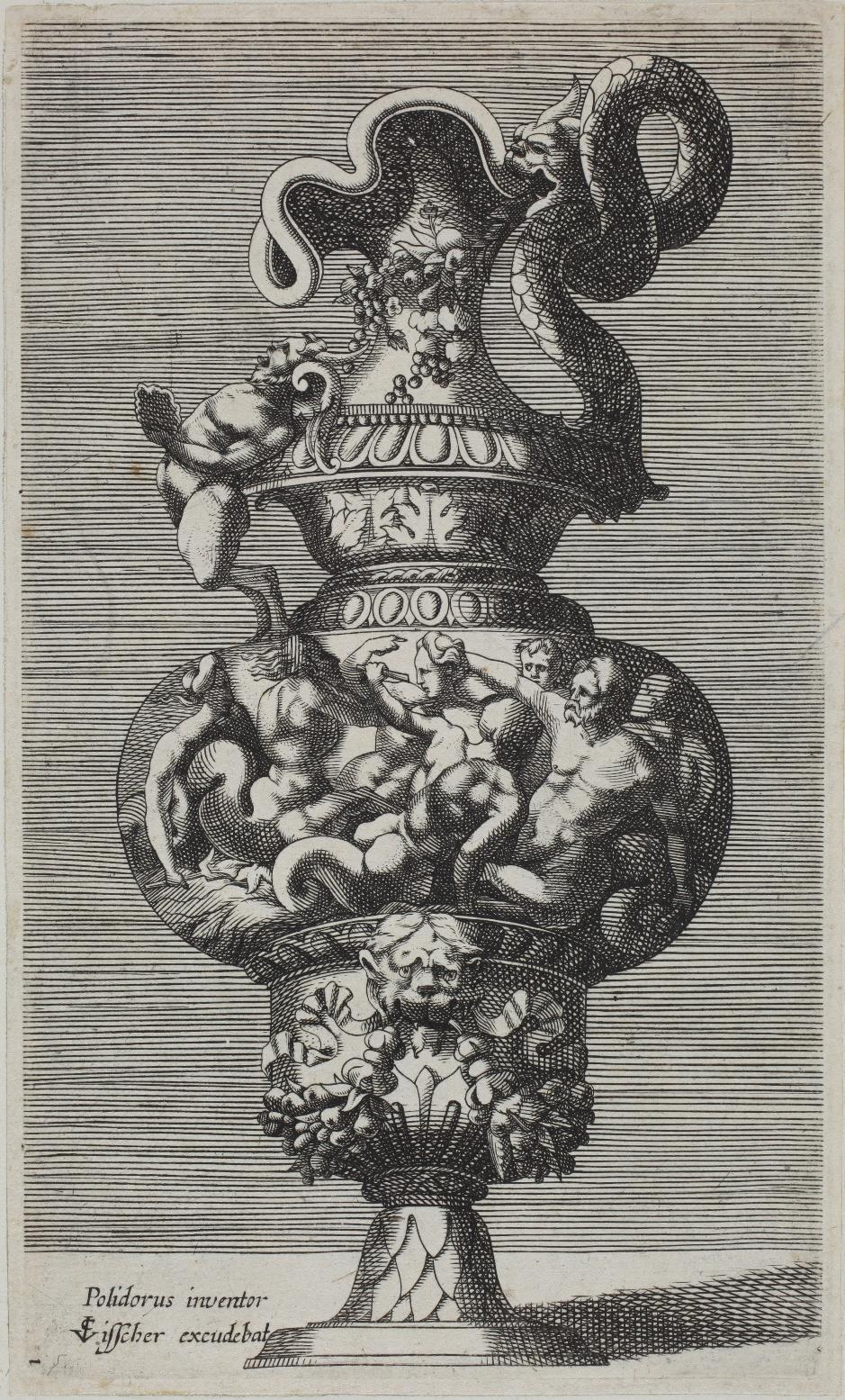

also attributed them to René Boyvin. Peter Fuhring notes that “Among the prints traditionally thought to be engraved by Boyvin, some are now given to Pierre Milan, including the set of vases.” (Peter Fuhring, p. 323). He refers to a handwritten note, probably by Jean Adhémar according to him, in the margin of a copy of Robert Dumesnil's catalogue kept in the Bibliothèque nationale.
The authorship of the compositions is also uncertain. In the edition by Claes Jansz. Visscher's edition, the first plate bears the inscription Polidorus inventor at the bottom left, thus attributing the drawings to Polidoro da Caravaggio (ca. 1499ca. 1543). The author of the online entry for a copy of the series in the British Museum notes: "Some of the vases [...] were loosely inspired by Polidoro's famous series; compare for instance the vase on plate 11 with plate 8 in the series engraved by Cherubino Alberti after Polidoro (1874,0808.292); both feature similar elements such as the term, the winged figures, the cornucopias, the handle. Same with plate 1 and Alberti's plate 4 (1874,0808.564); plate 2 and Alberti's plate 1 (1874,0808.561; decoration of the handles and the neck only); plate 3 and Alberti's plate 3 (1874,0808.563); plate 4 with Alberti's plate 5 (1873,1213.289); and plate 6 and Alberti's plate 7 (1874,0808.565)."
The influence of designs by Rosso Fiorentino has also been noted. Jacques Levron notes that "the model for the vases on plates 5, 6 and 8 would be the Rosso". Regarding the plate numbered 5, of which a preparatory drawing is kept at the Bibliothèque nationale de France, Peter Fuhring, however, notes that “The ewer illustrated in the fifth plate of the set (cat. no. 590.5; R. D., no. 139; fig. 161) is thought to derive from a design by Rosso Fiorentino. The signed drawing, which is
indented with a metalpoint for transfer to the copperplate (fig. 160), bears the signature of Léonard Thiry. There is no reason to doubt the signature: the hand of the drawing is identical to that in Thiry's preparatory
for the famous set of the Conquête de la Toison d’Or”.
TRANSLATION OF TITLES GIVEN BY LEVRON Nereids and Tritons Children's dance Two garlands Sacrifice of a bull A river god leaning on an urn Dance of male and female satyrs Preparations for a sacrifice Thetis, Saturn and Neptune Garlands carried by two women Two garlands of leaves and fruits Two winged genii Helmet and garland of leaves and fruit
drawings
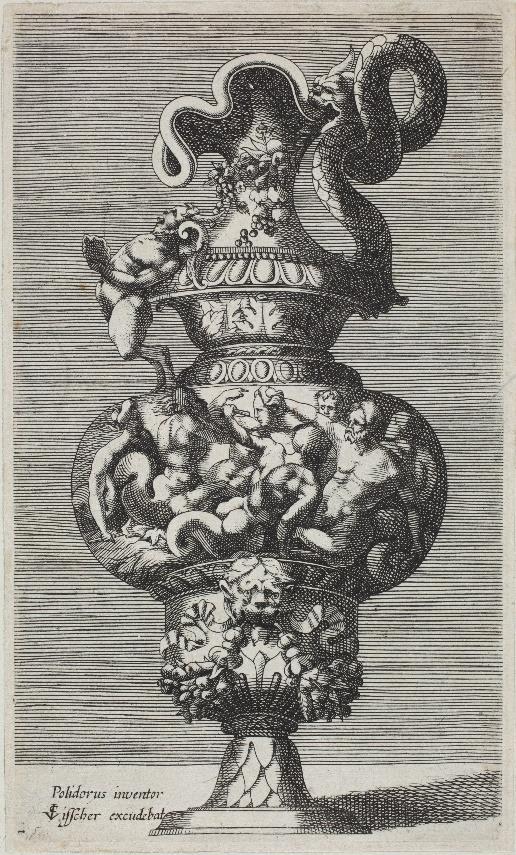

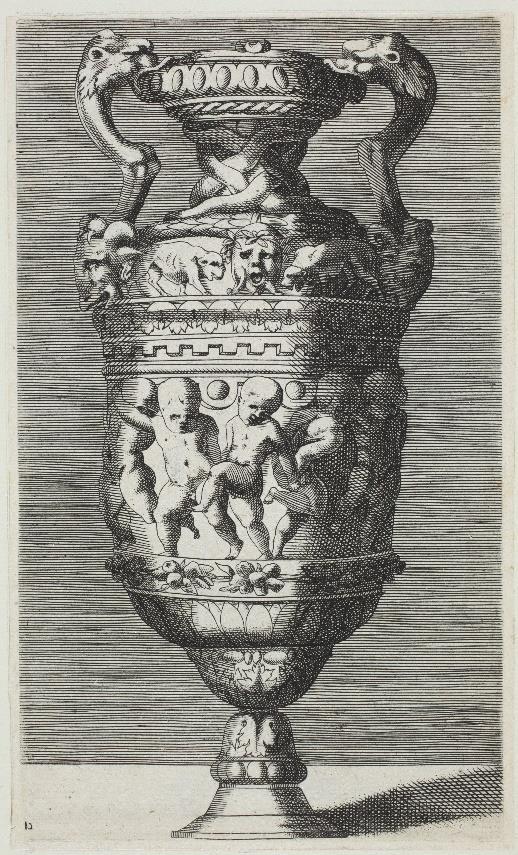









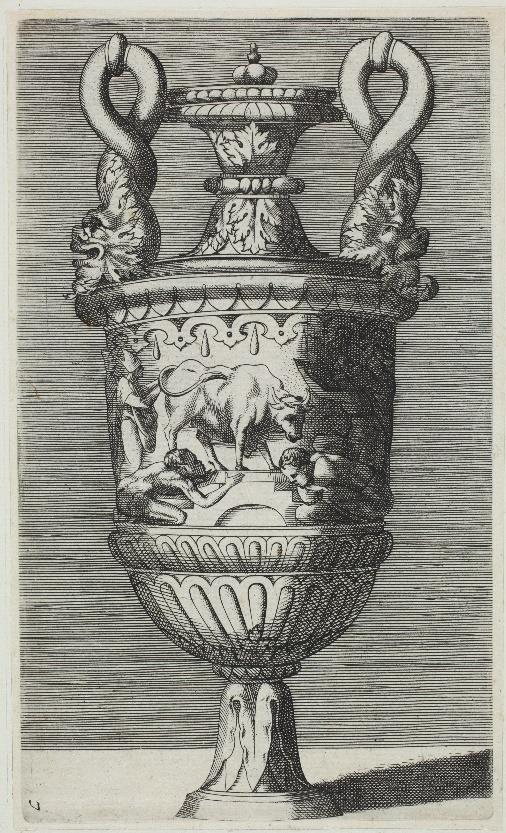





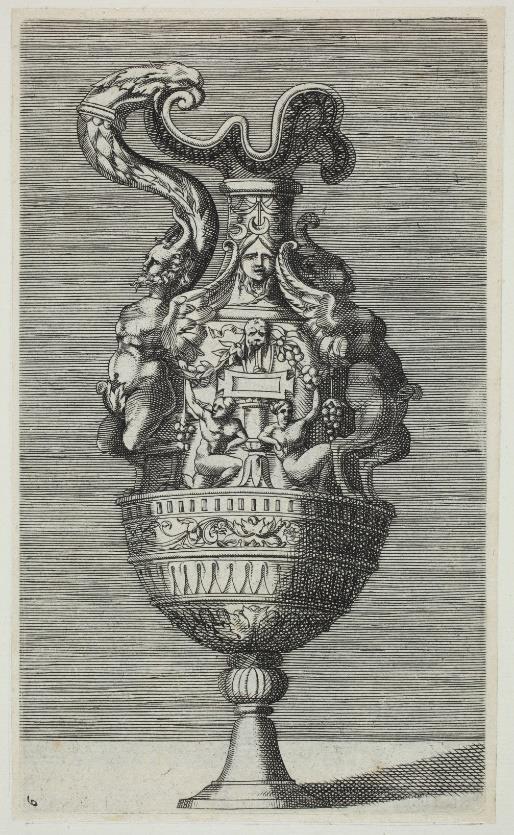







Aegidius SADELER II (ca. 1570 - 1629)
Antique vases after Polidoro da Caravaggio and Knives after Francesco de’ Rossi 1605
Complete series of 12 plates: Antique vases : Complete series of 10 numbered plates. Etching and engraving, 235 x 155mm. Hollstein 377 386, 2nd state (of 2) with Marco Sadeler’s address (before 1614 in or after 1650).
Fine impressions printed on laid paper.
This series was engraved by Aegidius Sadeler II in reverse of the series of vases printed in 1582 by Cherubino Alberti (1553 1615) after the famous frescoes by Polidoro da Caravaggio (ca. 1499 ca. 1543) (Bartsch XVII, p. 110 and 161 to 170).
“Never a printmaker, Polidoro was a decorative painter who, in the 1520s, executed number of murals on the façades of Roman buildings. Composed of illusionistic classical figure scenes, trophies and vases, they were not only highly visible but also revolutionary in design. Most remarkable were the vases painted on the Palazzo Milesi shortly before 1527, which Vasari, even though accustomed to the distortions of later Mannerist design, described as being ‘so curiously wrought that it would be hard to find anything more beautiful or novel’.” (Snodin, Michael, and Maurice Howard. Ornament: a social history since 1450. New Haven: Yale University Press, 1996, p. 34.)
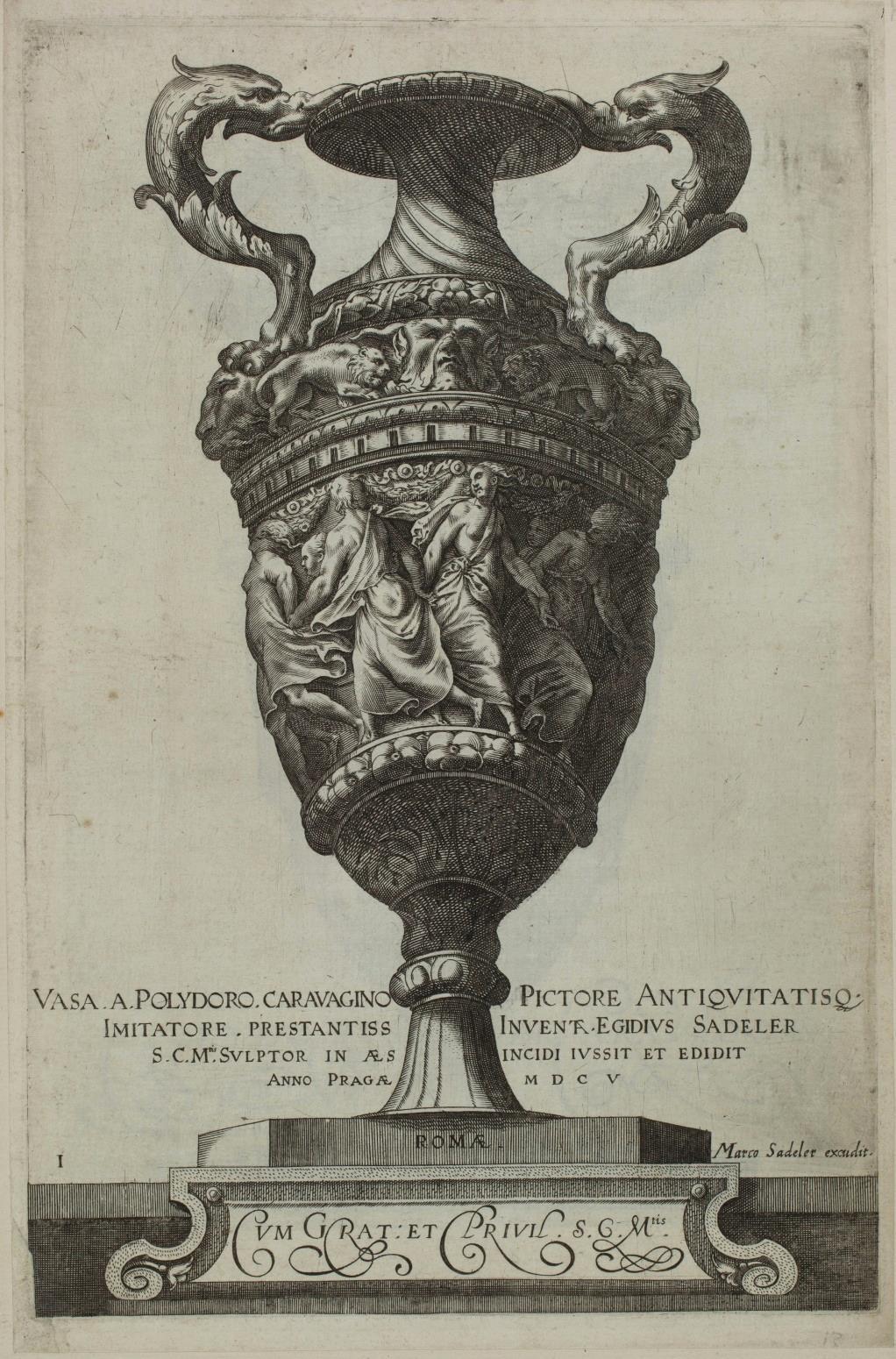

These vases were a great success and were copied extensively. “By 1544, versions had appeared in a Roman set of prints and some of the designs reached France in the middle years of the century through interpretations by Ducerceau and René Boyvin”
In 1582, Cherubino Alberti dedicated a series of prints solely to these vases for the first time. Alberti's prints were then widely copied. All these prints contributed to the lasting diffusion of Polidoro's designs in the fine and decorative arts, making them “a source of motifs and pictorial props for decorative and easel painters, including artists like Sir Joshua Reynolds, and, much later, Cézanne” (Michael Snodin and Maurice Howard: Ornament: a social history since 1450, 1996, p. 35).
Knives: Complete series of 2 plates with 2 knives each, numbered 11 and 12 (probably following the previous series of vases). Engraving, 245 x 155 mm. Hollstein 387 388, 2nd state (of 2) with Marco Sadeler’s address.
Copies in reverse after Cherubino Alberti (Bartsch XVII, 171 and 172). Engraved after Francesco de’ Rossi, known as Francesco Salviati.
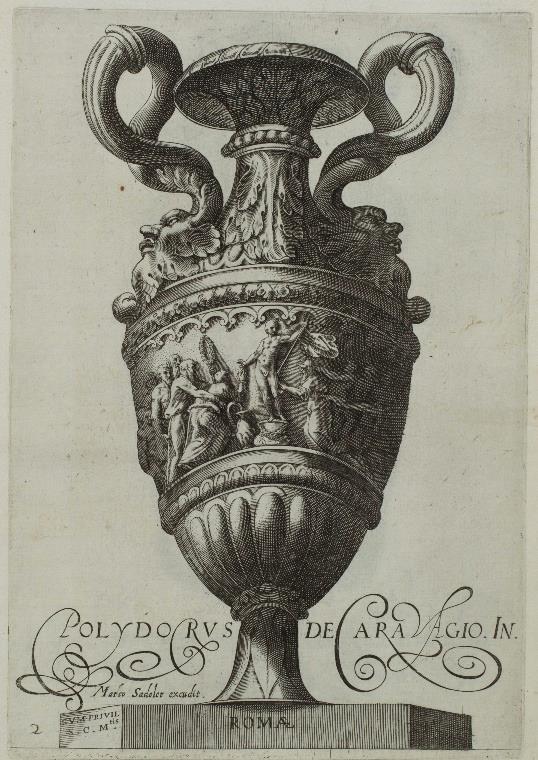



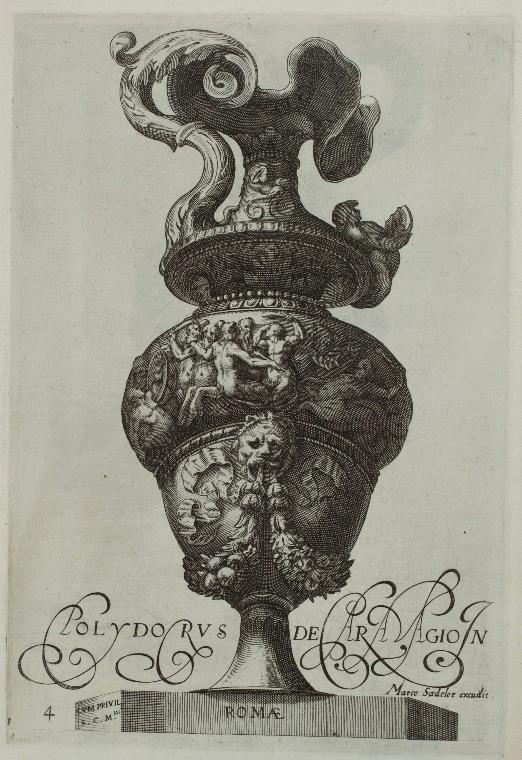









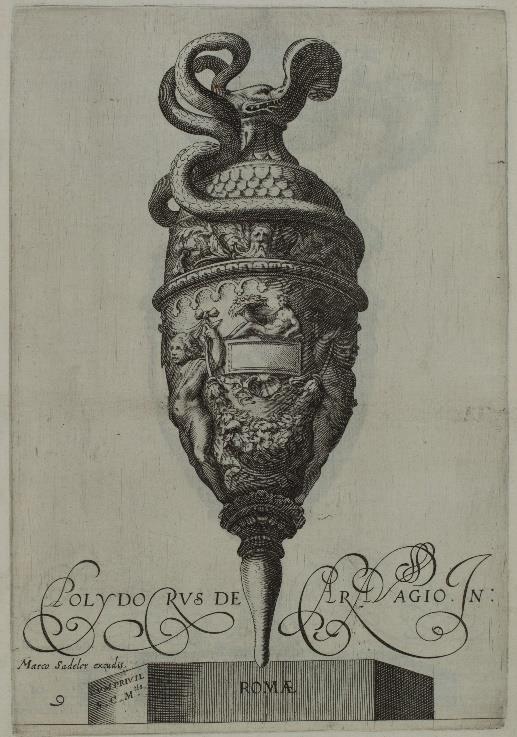









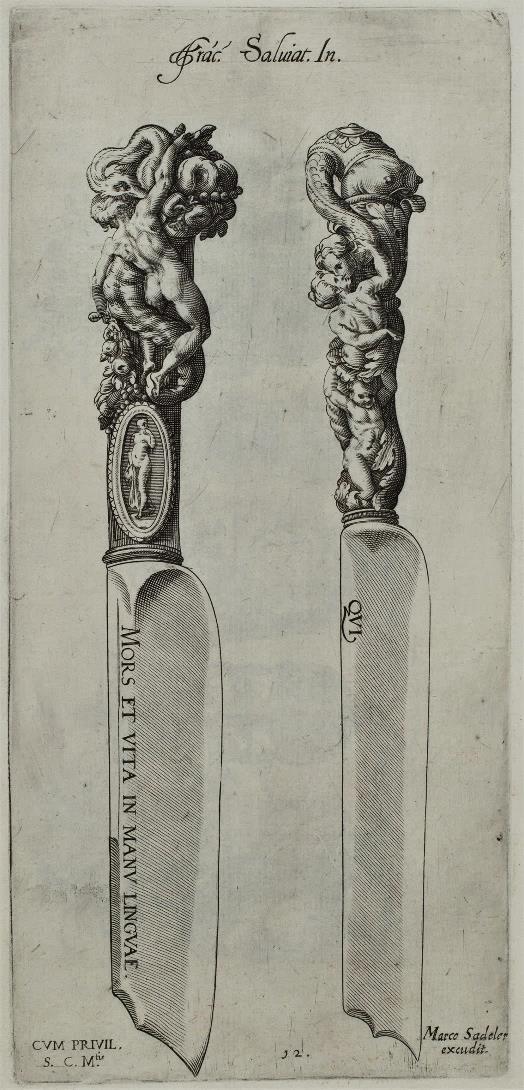

Claude-Henri WATELET (1718 - 1786)
Sei vasi disegni dal signor Pierre intagliati dal suo amico Watelet 1749
Rare complete series of 6 plates including a title plate, etched after Jean Baptiste Marie PIERRE (1714 1789). Guilmard p. 212, Le Blanc 90. Peter's preparatory drawings are listed by N. Lesur and O. Aaron under the numbers *D. 227 to *D. 233.
The friendship between Watelet and Pierre dates from their meeting in Rome in 1736. Jean Baptiste Marie Pierre was then 22 years old. He had just won the Academy's grand prize for painting (the famous Prix de Rome) and was allowed to stay at the Académie de France in Rome as pensionnaire du roi (the king's boarder) between 1735 and 1740. Claude Henri Watelet was 18 years old and on a trip to Europe which took him to Rome. "The painter and the amateur thus formed a friendship that would only end with the death of the latter on 12 January 1786. It was to be coupled throughout their lives with a close community of taste. Forged during their stay in Rome, it continued with an artistic collaboration as soon as they returned to Paris.” (Nicolas Lesur, translated by us). This friendship was expressed in prints. In 1743, Pierre created drawings, engraved by Watelet for Silvie, his first written work. In 1758 59, they etched five prints together (Lesur and Aaron, op. cit., 2009, G. 26 to G. 29 and G. 36). In 1760, Watelet's major written work, L'Art de peindre, Poème avec des réflexions sur les différentes parties de la peinture, was published, which "ranks among the most important treatises on painting of the 18th century" (N. Lesur, translated by us). It is "in a way the high point of this artistic friendship. Watelet's book is illustrated
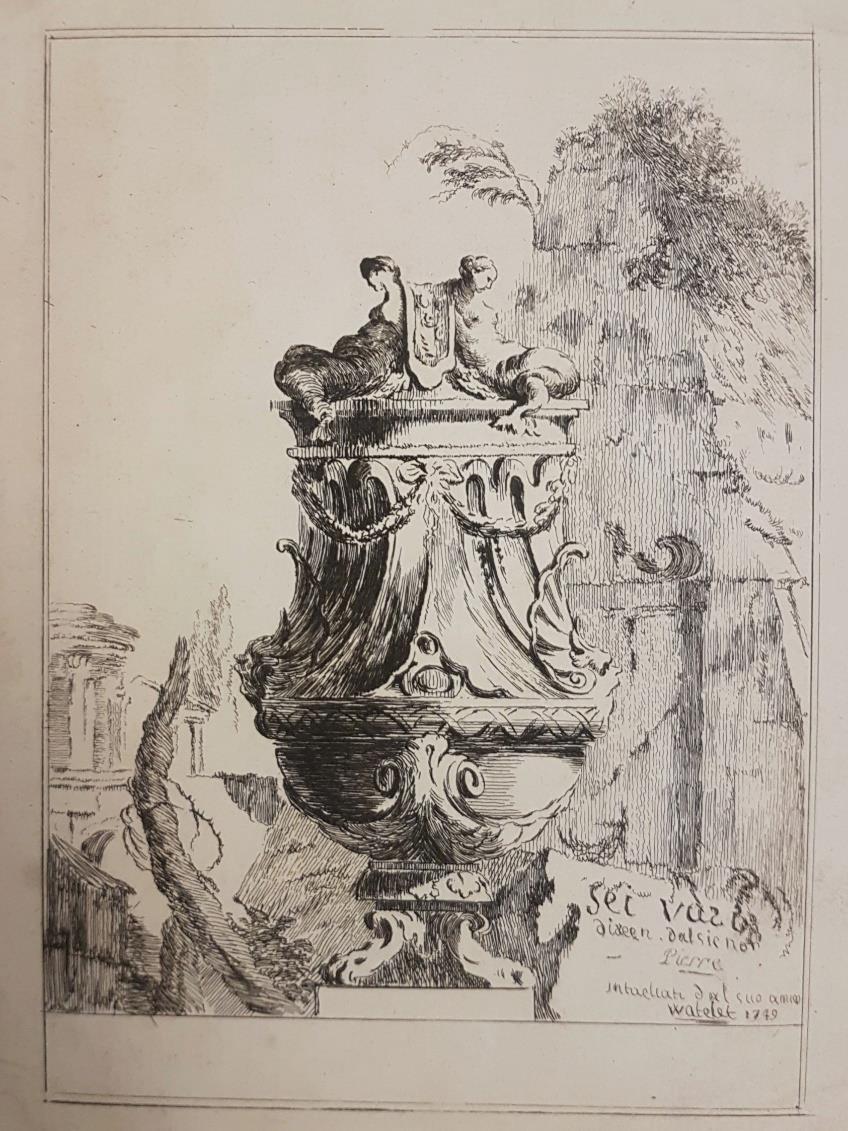

with drawings by Pierre, engraved by the amateur himself and by his mistress Marguerite Le Comte. Pierre thus provided the frontispiece, the four header vignettes and the culs de lampe of the four chants, the drawings after the Venus de Medici and after Antinous, as well as the medallions depicting the great old masters placed in the exergue of each part of the reflections in prose.” (our translation).

The title of the series of vases engraved by Watelet in 1749 also testifies to this friendship and their artistic collaboration: "Sei vasi disegni dal signor Pierre intagliati dal suo amico Watelet" [Six vases designed by M. Pierre and engraved by his friend Watelet].
In 1752, Watelet produced two other series of vases, one of which was based on drawings by Pierre: Raccolta di Vasi, dedicata alla Signora illustriss. Daronserai. References: « Lorsque la théorie la plus savante se joint à la pratique la plus heureuse. » Jean Baptiste Marie Pierre et L’Art de Peindre de Claude Henri Watelet (1760) (Read online); N. Lesur and O. Aaron, Jean Baptiste Marie Pierre (1714 1789), Premier peintre du roi, 2009.



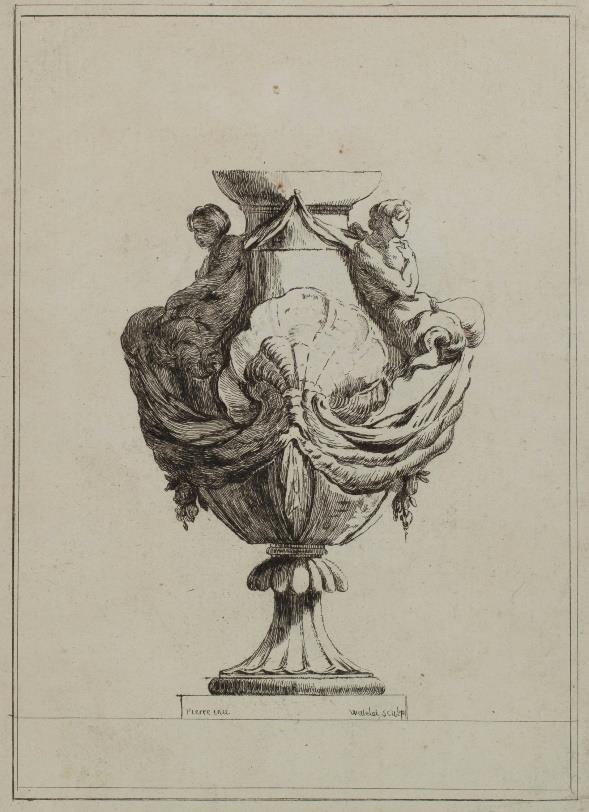

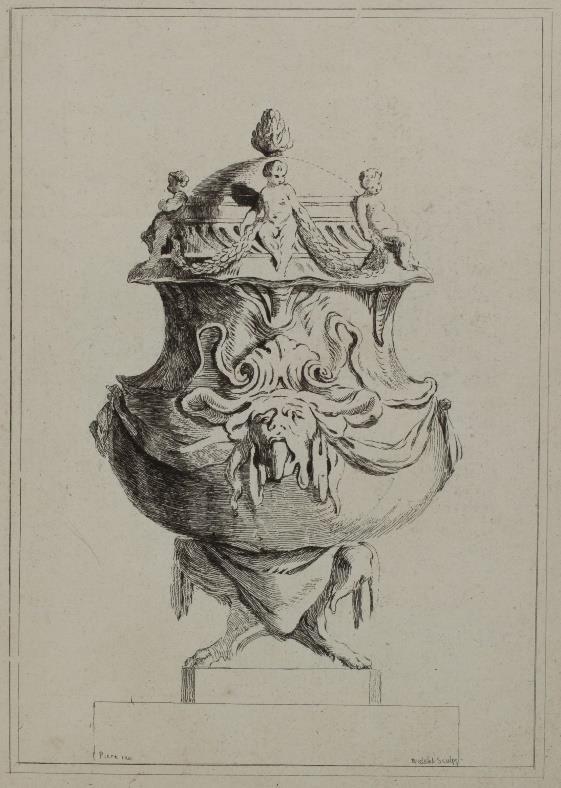



Jean Laurent LE GEAY (1708 - 1790)
Vases, Tombs, Ruins and Fountains.
Rare collection of 41 plates from 6 series. Collection de divers sujets de Vases, Tombeaux, Ruines et Fontaines. Utile aux Artistes Inventée et gravée par G. L. Le Jeay Architecte, 1770 [Collection of various subjects of Vases, Tombs, Ruins and Fountains. Useful to Artists Invented and etched by G. L. Le Jeay Architect] 29 plates. A title plate for the entire collection, followed by: Vasi Invention di Giovani Lorenzo Le Geay Architetto Intagliate da lui stesso: title plate and 3 plates, including two impressions from different states of one of the plates
Tombeaux Inventione di Giova Lorenzo Le Geay Architet Intaglia da luy stesso in luc(e) MDCCLXVIIII 1769: title plate and 7 plates, including two impressions from different states of one of the plates
Rovine Inventione di Giovan Loren Le Geay Architett Intagliate da lui stesso in luce - 1768: title plate and 7 plates Fontane per l’aqua del te’ Inventione di Giovani Lorenzo Le Geay Architetto Intagliate da lui messe in luce stesso MDCCLXVII - 1767: two impressions of different states of the title plate and 3 plates, includingtwoimpressionsfromdifferentstatesofoneoftheplates.
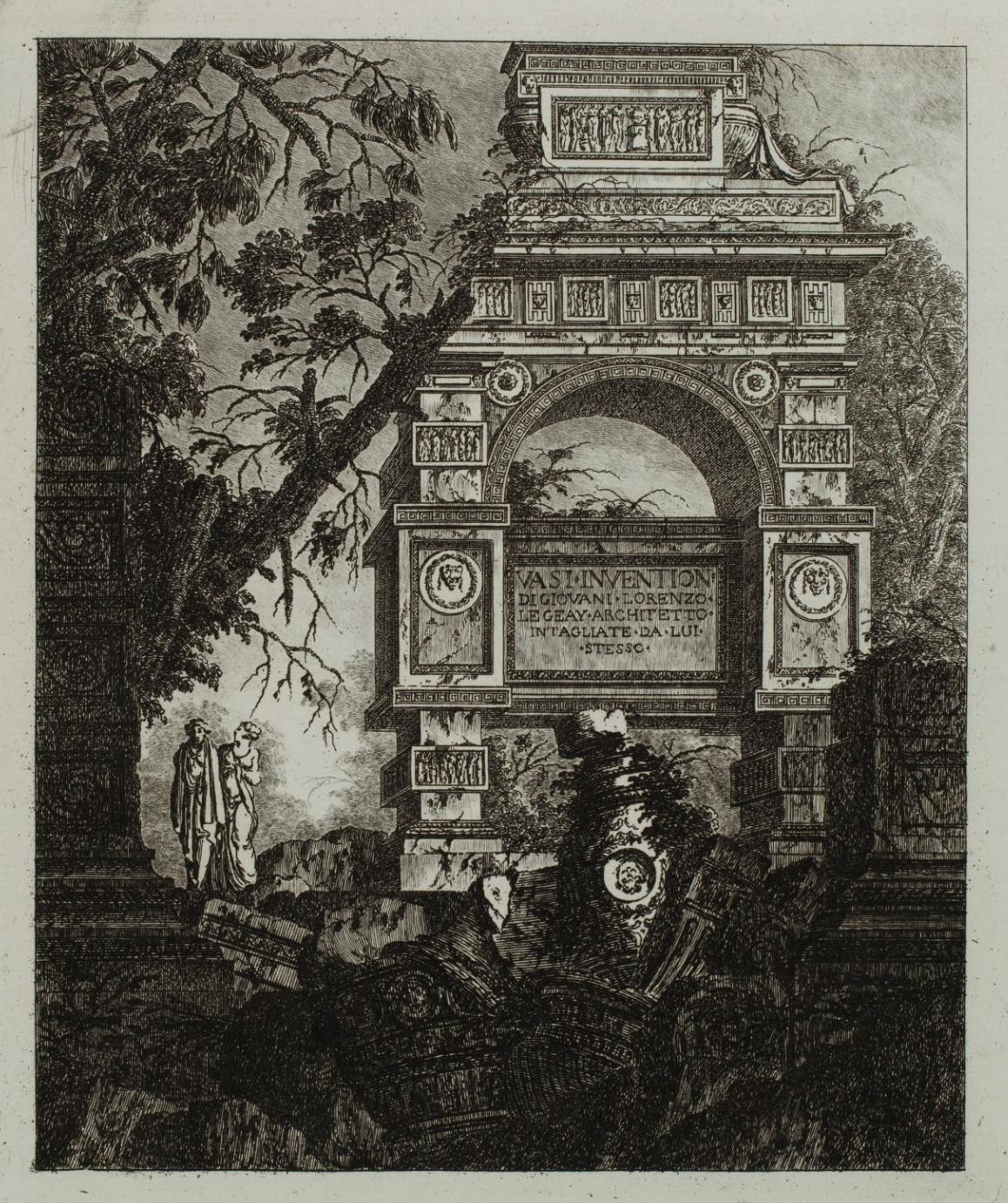

Guilmard indicates that the four series are composed of 6 plates each, making a total of 24 plates plus the collection’s title plate. This is the number of plates found in our collection after the general title plate, to which must be added 4 state proofs. The plates of the series, which are very similar in subject matter, have been mixed: this is also the case in one of the volumes held at the Institut National d'Histoire de l'Art, where all the plates correspond to ours but are assembled in a different order.
Fontaines inventé[es] et gravées par Legeay arch. Et [Fountains invented and etched by Legeay architect […]]
Incomplete series of 5 plates (from a series of 7 plates) including a title plate. Guilmard p. 238. Guilmard and the Inventaire du Fonds Français mention 6 plates in this series, but the copy in the INHA’s collections comprises 7 plates.
Divers tombeaux inventé et gravez par Le Geay
[Different Tombs invented and etched by Le Geay]
Complete series of 7 plates including a title plate. This copy is in keeping with the one kept at the INHA. IFF undescribed, Guilmard undescribed. Destailleur states in the table of contents of the second volume: "Some of Le Geay's suites are very rare", which he signs with his monogram.
Jean Laurent Le Geay was a French neoclassical architect. He was awarded the Grand Prix of the Royal Academy of Architecture in 1732 and lived in Rome between 1737 and 1742. He then worked for Duke Christian-Louis II of Mecklenburg Schwerin before being appointed first architect to Frederick II of Prussia.


Yves Sjöberg, in the Inventaire du Fonds Français, emphasises the visionary character of his series of vases, tombs, ruins and fountains. The ornamental elements are inserted into ruined architectures overgrown with vegetation that evoke the work of Piranesi. They are populated by strange characters. This aspect, on the other hand, disconcerted Guilmard, who spoke of these plates as "bizarre compositions and of an exaggerated Louis XVI style".
References: Erouart, Gilbert: L'architecture au Pinceau. Jean Laurent Legeay. Un Piranésien français dans l'Europe des Lumières, 1982; Robin Middleton, The Burlington Magazine 125 No. 969 (December 1983), pp. 766 767.
As Guilmard points out, the general title piece of the first four suites does not have the same style as the plates they contain: in a banal classical style, it is probably not by Le Geay.
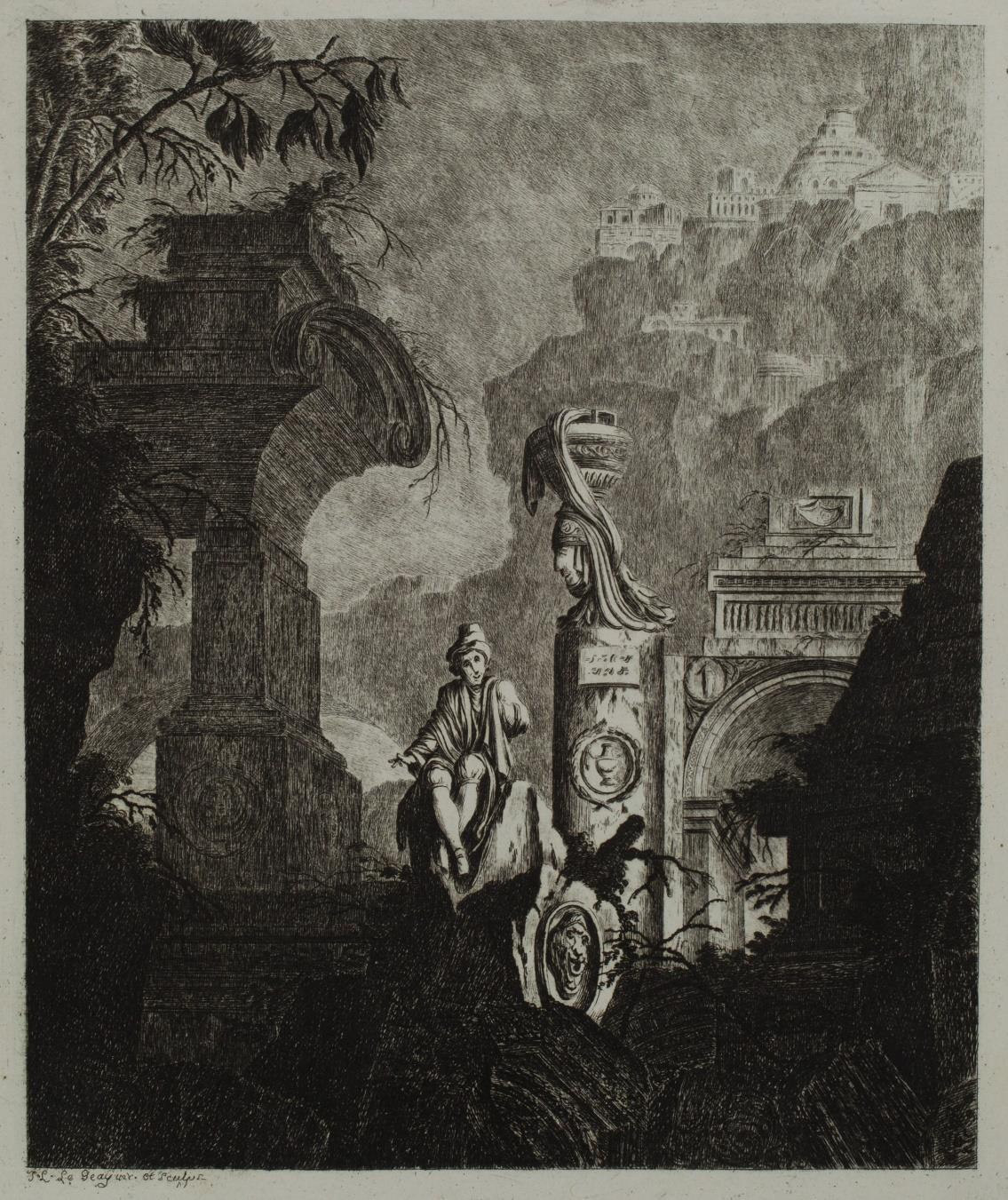

VOLUME 1: 15 SERIES, 101 PLATES

Jacques DAMERY (1626 - 1685 ?)
Suite de douze vases antiques, dédiée au Secrétaire des Brefs du Pape Alexandre VII, Rome 1657.
Incomplete series of 11 impressions from 10 (of 12) plates in the series: Destailleur indicates in the table of contents that one plate from the series is missing, but in fact two are missing, as there are two impressions of one of the plates. Robert-Dumesnil 1 to 12. Guilmard p. 85 (Jean Damery).
Jacques Damery was a painter of flowers, fruits and vases.
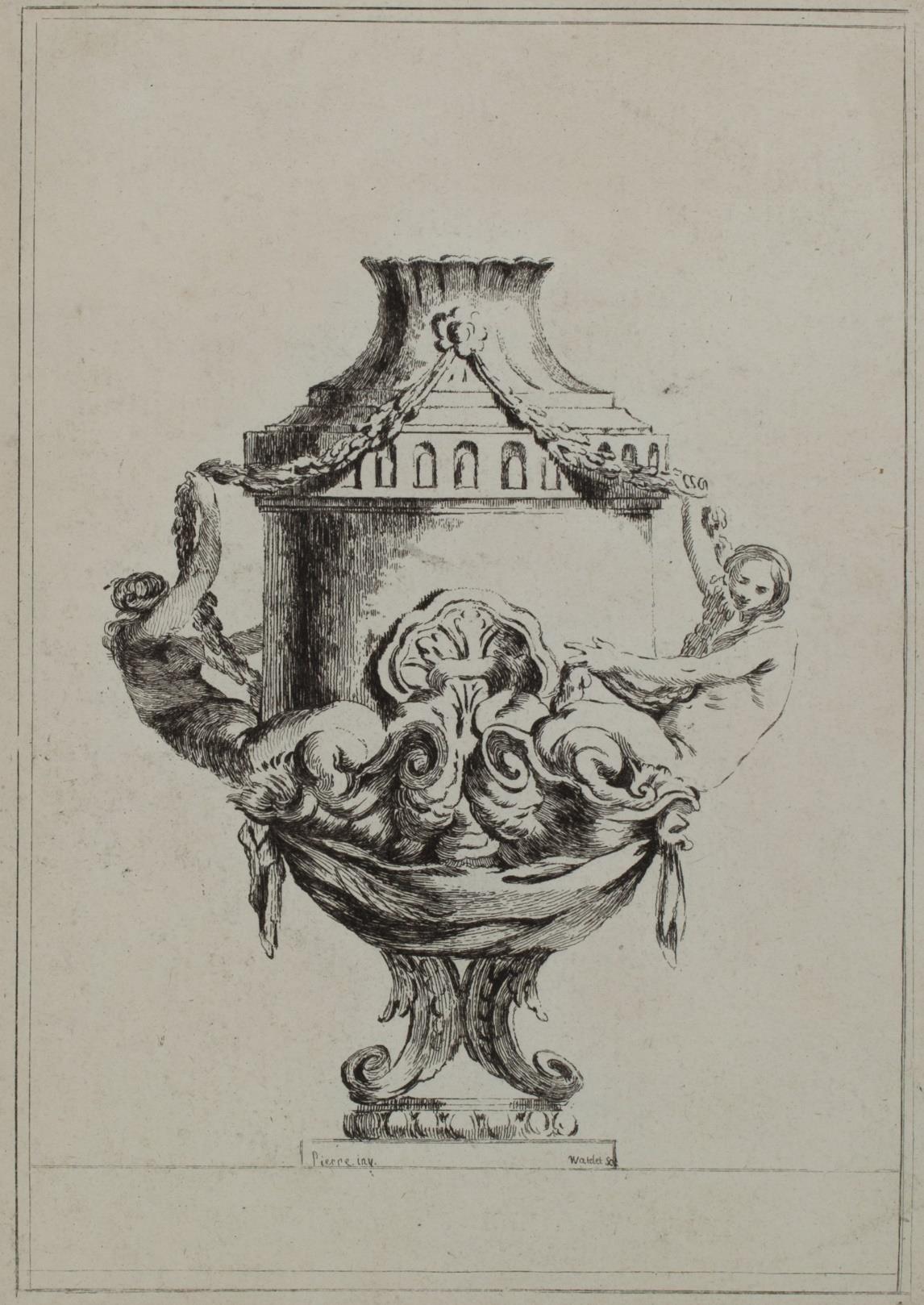

MANIERE (fl. in the 18th century)
Première suitte de Vases antiques d’après Saly, et autres
Series of 6 plates with two vases each, engraved after in particular by Jacques François Saly (1717 1776). Guilmard undescribed.
MANIERE (fl. in the 18th century) Deuxieme suitte de Vases antiques d’après Saly, et autres Series of 6 plates with two vases each, engraved after in particular after Jacques François Saly (1717 1776). Guilmard undescribed.
F. BRARD (fl. in the 18th century)
Ie Suite de vases par differends maîtres
Incomplete series of 6 plates after Louis Doré. Edition with numbers. Guilmard p. 268 (Doré).
Another copy of this series, in an edition before the numbers, is bound in the 4th volume.
Claude-Henri WATELET (1718 – 1786)
Sei vasi disegni dal signor Pierre intagliati dal suo amico Watelet 1749
Complete series of 6 plates including a title plate, etched after Jean-Baptiste Marie Pierre. Guilmard p. 212, Le Blanc 90.
→ Read the full description above in the catalogue


Charles-François JOLY (fl. in the 2nd part of the 18th century)
Suite de vases d’après l’antique dessiné et gravé par C. F. Joly 1774
Complete series of 6 plates printed in red. Guilmard p. 245.
Jean HOUDAN (fl. c. 1775) Ier Cahier de petits vases Composés et gravés par J. Houdan
Complete series of 6 plates. Guilmard p. 237.
MOITHEY the Elder (fl. at the end of the 18th century) Nouveau livre de vases 1767
Complete series of 6 plates printed in red. Guilmard p. 259. Provenance: Luigi Calamatta (1801 1869), Italian painter and printmaker. His blind stamp on the first plate (Lugt 1717). Another copy of this series is bound the 3rd volume.
Jean-Jacques AVRIL known as AVRIL the Elder (1744 - 1831)
Ir Cahier de vases par Avril Lainé
Series of 6 plates. Guilmard p. 268.
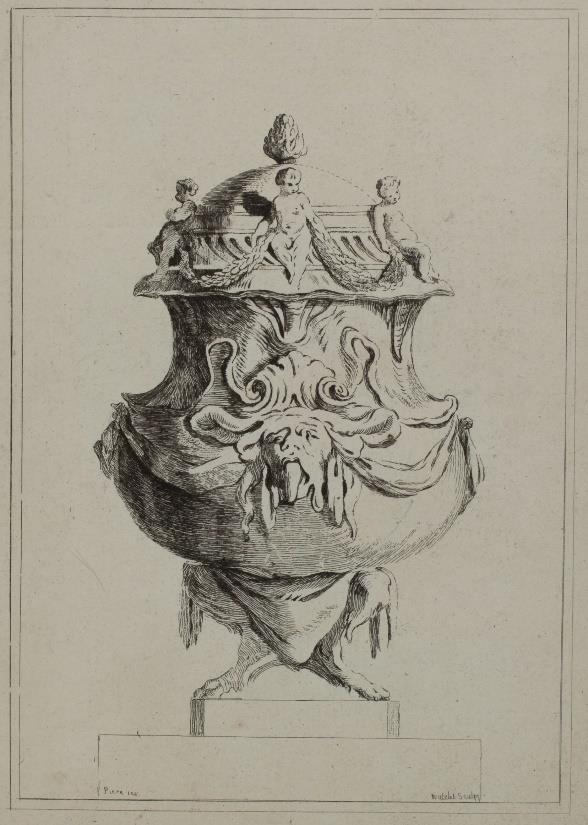



Jean-Jacques AVRIL known as AVRIL the Elder (1744 - 1831)
IIe Cahier de vases par Avril l’ainé Series of 6 plates. Guilmard p. 268. Guilmard seems to have seen only one plate of this series.
Charles DUPUIS (fl. in the 18th century) Recueil de Vases dessiné et gravé par C. Dupuis, Architecte de Versailles
Incomplete series of 12 plates from 11 (of 13): two plates are missing, and there is two impressions of one plate. Guilmard p. 262, IFF 13. RAUX (fl. c. 1758-1778) Fontaine publique, Tombeau antique, three epitaphs numbered 3, 4, 5, Croisée - c. 1758 6 plates. Guilmard p. 237 238. Raux was an architect and printmaker.
Jean Louis PRIEUR (1732 - 1795) (attributed to)
Anses de vases 6 plates. Guilmard p. 256 258 undescribed. L. Prieur was a draughtsman and ciseleur for the King and he worked in Paris in the 2nd part of the 18th century.
ANONYMOUS (fl. in the 18th century)
Atribues de vases
Complete series of 6 plates published by Crépy.
ANONYMOUS (fl. in the 18th century) Nouveaux vases antiques
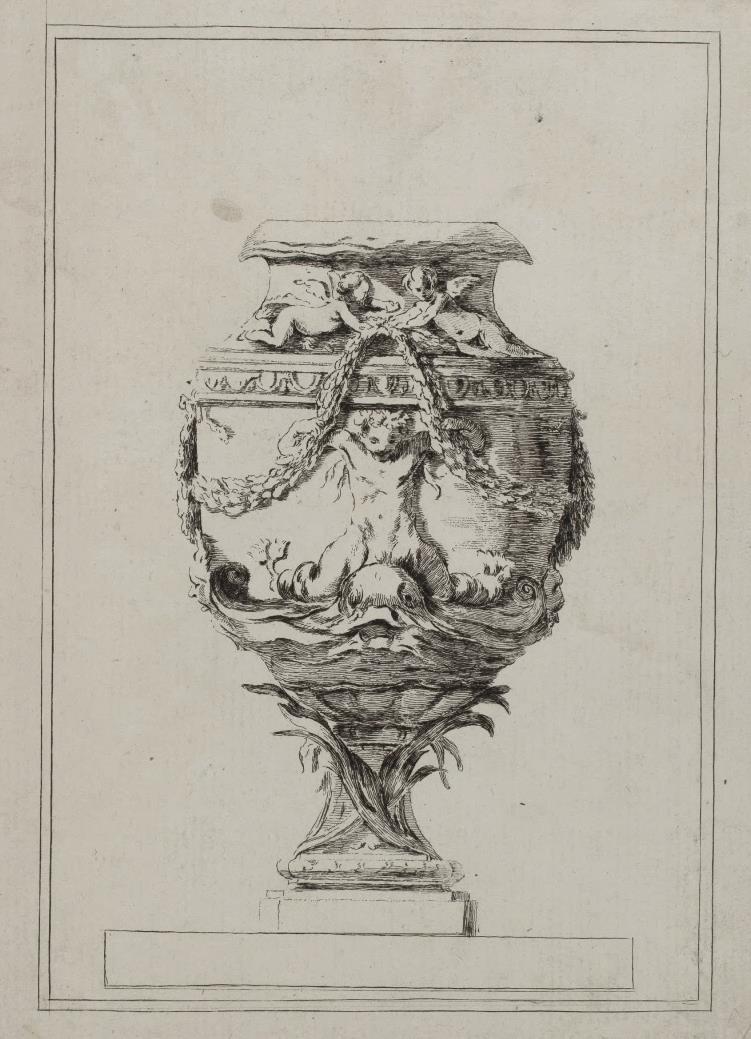
Complete series of 6 plates published by Crépy.

Juste Nathan François
BOUCHER
known as BOUCHER fils (1736 - 1782) Suite 3e de douze vases, Composés par PETITOT
Complete series of 12 plates including a title-plate. With: an impression of the title plate before the letter. Guilmard p. 225 (Petitot).




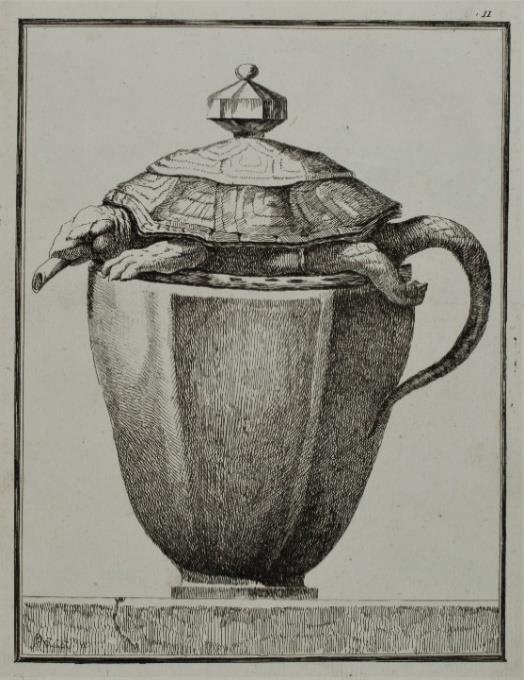
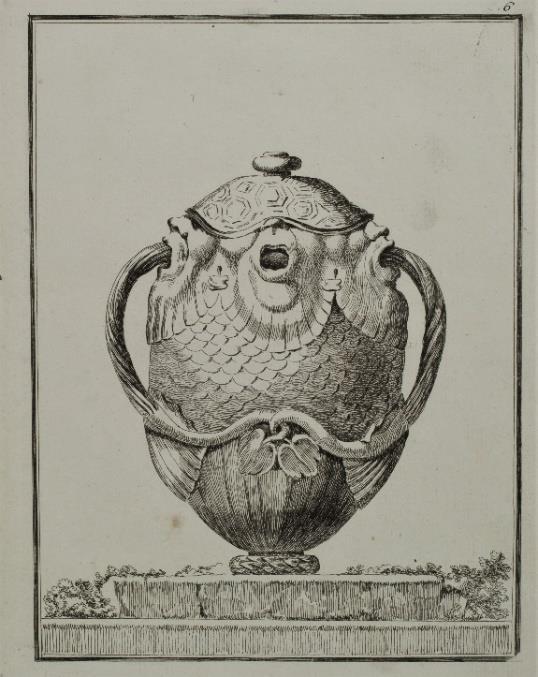
2: 7 SERIES,
VOLUME
53 PLATES
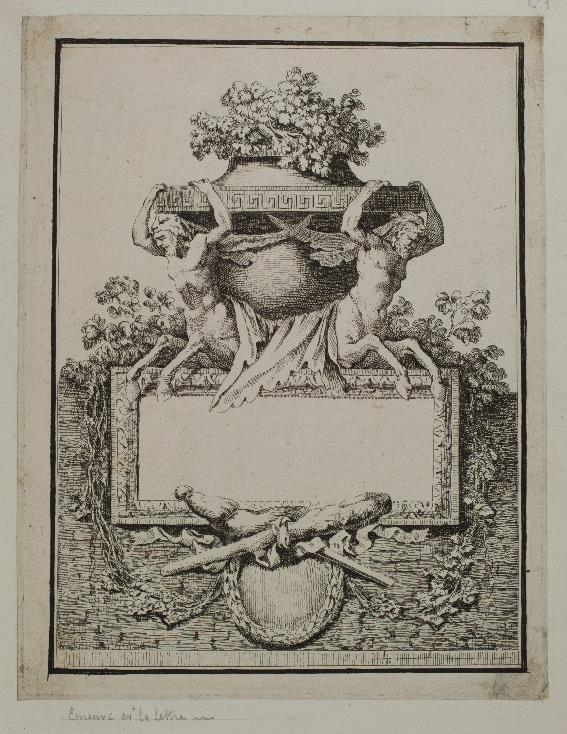

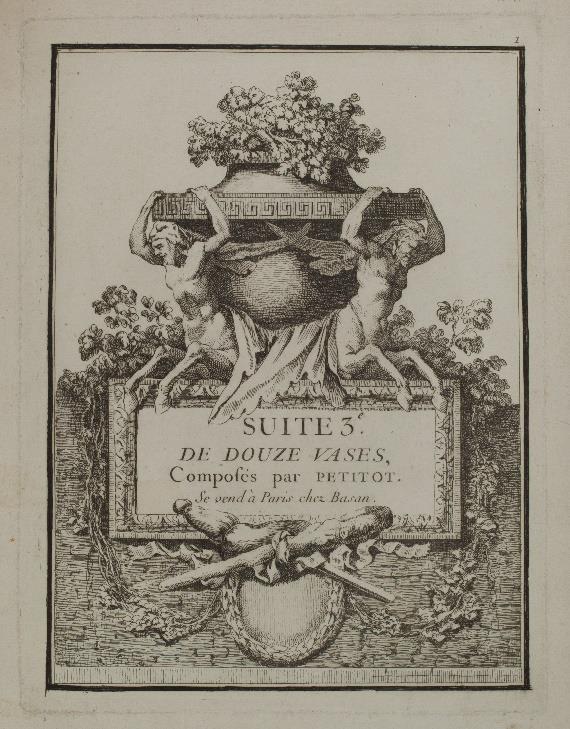

Jean Laurent LE GEAY (1708 – 1790)
Collection de divers sujets de Vases, Tombeaux, Ruines et Fontaines. Utile aux Artistes Inventée et gravée par G. L. Le Jeay Architecte 1770
19 plates. A title plate for the entire collection, followed by: Vasi Invention di Giovani Lorenzo Le Geay Architetto Intagliate da lui stesso: title plate and 3 plates, including two impressions from different states of one of the plates
Tombeaux Inventione di Giova Lorenzo Le Geay Architet Intaglia da luy stesso in luc(e) MDCCLXVIIII 1769: title plate and 7 plates, including two impressions from different states of one of the plates
Rovine Inventione di Giovan Loren Le Geay Architett Intagliate da lui stesso in luce - 1768: title plate and 7 plates Fontane per l’aqua del te’ Inventione di Giovani Lorenzo Le Geay Architetto Intagliate da lui messe in luce stesso MDCCLXVII 1767: two impressions of different states of the title plate and 3 plates, including two impressions from different states of one of the plates. Guilmard indicates that the four series are composed of 6 plates each, making a total of 24 plates plus the collection’s title plate. This is the number of plates found in our collection after the general title plate, to which must be added 4 state proofs. The plates of the series, which are very similar in subject matter, have been mixed: this is also the case in one of the volumes held at the Institut National d'Histoire de l'Art (INHA), where all the plates correspond to ours but are assembled in a different order.


Jean Laurent LE GEAY (1708 - 1790)
Fontaines inventé[es] et gravées par Legeay arch. Et
[Fountains invented and etched by Legeay architect […]]
Incomplete series of 5 plates (from a series of 7 plates) including a title plate. Guilmard p. 238. Guilmard and the Inventaire du Fonds Français mention 6 plates in this series, but the copy in the INHA’s collections comprises 7 plates.
Jean Laurent LE GEAY (1708 - 1790)
Divers tombeaux inventé et gravez par Le Geay
[Different Tombs invented and etched by Le Geay]
Complete series of 7 plates including a title plate. This copy is in keeping with the one kept at the INHA. IFF undescribed, Guilmard undescribed.
→ Read the full description above in the catalogue


C. BRESSE (fl. c. 1760)

4e Suite de Vases d’Après Petitot et Autres Series of 12 plates, after Ennemond Alexandre Petitot (1727 1801) and Simon Challe (1719 1765). The name of the printmaker appears on the 4th plate. Guilmard undescribed.
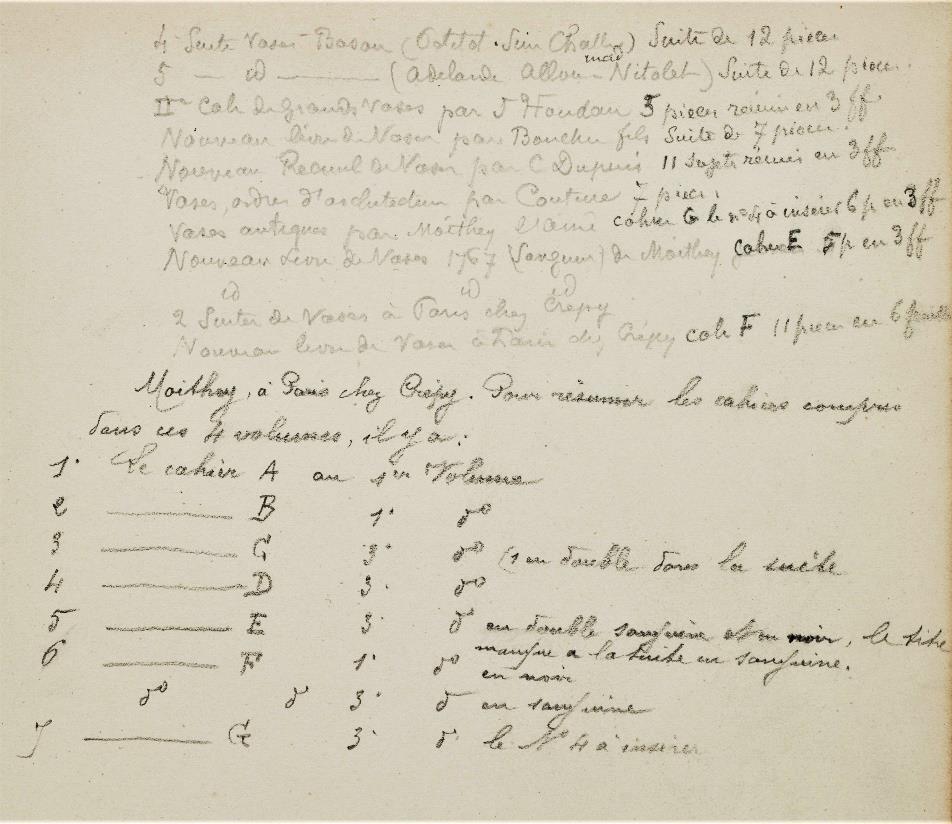
13
VOLUME 3:
SERIES, 93 PLATES


Adélaïde ALLOU (fl. c. 1770) and P. NICOLET (fl. in the 18th century)
Cinquième suite de Vases Composée de 12 feuilles
Complete series of 12 plates including a title plate and 5 plates signed by Adélaïde Allou, 3 plates signed by P. Nicolet and 3 unsigned plates. Guilmard p. 262 (Nicolet), IFF 7 and 8 (two plates only).
The role of women printmakers in the 18th century ornamental print market has been highlighted: “Women printmakers and amateurs contributed significantly to the market for ornament prints. […] however, their gender sometimes threw the quality of their work into question. […] Ornament prints bywomen abound nevertheless, particularly in the subcategory of vase designs. The amateur Adélaïde Allou, for example, whose oeuvre included a series of landscapes after Hubert Robert and Jean Honoré Fragonard, etched a series of prints after P. Nicolet’s drawings for vases that were then published by Basan.” (Elizabeth M. Rudy in Artists and Amateurs: Etching in Eighteenth Century France,2013,p. 65).
Jean HOUDAN (fl. c. 1775) IIe Cahier de grands Vases Composés et Gravés par J. Houdan
Incomplete series of 5 plates (of 6). Guilmard p. 237.
Juste Nathan François BOUCHER known as BOUCHER fils (1736 - 1782)
Nouveau Livre de Vases par F. Bo….
Series of 7 plates. Our copy has the same plates as the one kept in the INHA. Guilmard mentions 8 plates for this series. Guilmard p. 232.


Charles DUPUIS (fl. in the 18th century)
Nouveau Recueil de Vases inventés par C Dupuis
Series of 1 title plate and 5 plates with two vases each. 12 plates are mentioned in the IFF. Guilmard undescribed, IFF 13.
Joseph-Abel COUTURE known as COUTURE the Elder (fl. at the end of the 18th century) Recueil de vases analogues aux cinq ordres d’architecture, d’après Couture
Frontispiece by Nicolet and 6 plates of vases signed by Couture. Guilmard p. 263. Guilmard says he "has seen only four pieces: Ionic vase, Tuscan vase, Corinthian vase and composite vase". (our translation). MOITHEY the Elder (fl. at the end of the 18th century) Vases antiques par Moithey L’aîné - 1767 Complete series of 6 plates. Guilmard p. 259.
MOITHEY the Elder (fl. at the end of the 18th century)(?)
Nouveau livre de vases 1767
Series of 6 anonymous plates printed in red. Guilmard p. 259.
MOITHEY the Elder
(fl. at the end of the 18th century)
Nouveau livre de vases 1767
Complete series of 6 plates printed in red. Guilmard p. 259.
Another copy of this series is bound in the first volume.
ANONYMOUS
6 plates of vases printed in red.
Jacques JUILLET (born in 1739)
1er Cayer de différens Vazes des plus Nouveaux - 1768
Guilmard p. 232 undescribed, IFF 22.
Complete series of 6 plates, numbered 1 to 6.
Jacques JUILLET (born in 1739)
2me suite de Vases 1768
Complete series of 6 plates, numbered 7 to 12. Guilmard p. 232 undescribed, IFF undescribed.
ANONYMOUS
Nouveau livre de vases
Set of 8 plates.
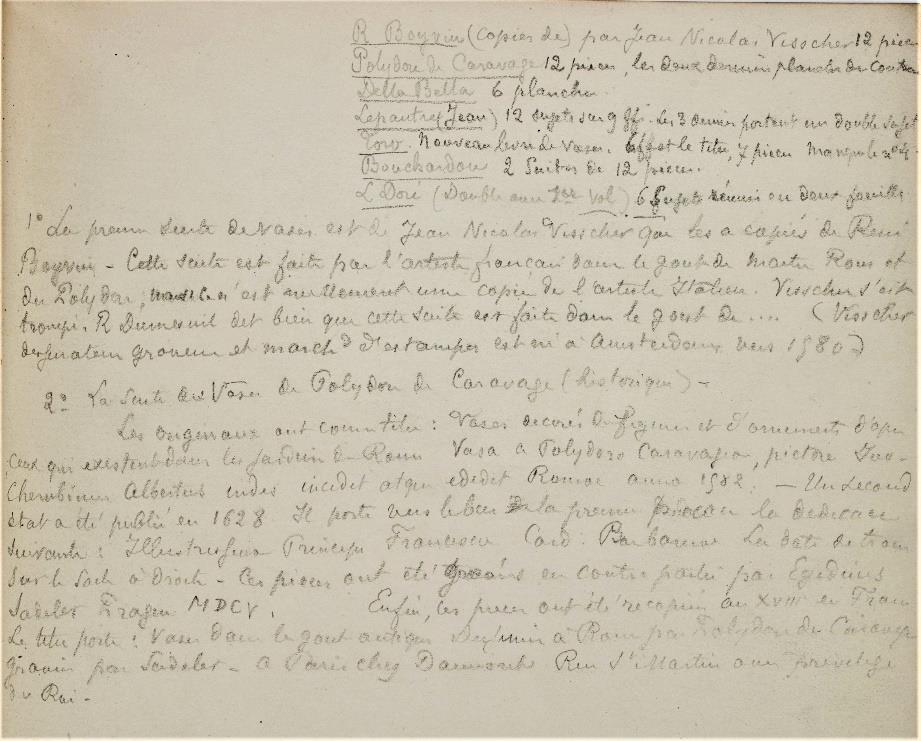

VOLUME 4: 10 SERIES, 78 PLATES
René BOYVIN (c. 1525 - 1598 or 1625/6) or Pierre MILAN (fl. c. 1542-1557) Twelve vases Complete series of 12 plates, published by Claes Jansz. Visscher (1587 1652). Robert Dumesnil 135 146, Levron 255 266. → Read the full description above in the catalogue


Aegidius SADELER II (c. 1570 - 1629)
Antique vases after Polidoro da Caravaggio
1605
Complete series of 10 plates. Hollstein 377-386, 2nd state (of 2) with Marco Sadeler’s address (before 1614 - in or after 1650). Reversed Reversed copies after the 1582 series by Cherubino Alberti (Bartsch XVII, p. 110, 161 to 170).
Aegidius SADELER II (c. 1570 - 1629)
Knives - 1605
Complete series of 2 plates with two knives each, numbered 11 and 12 (probably following the previous series of vases). Hollstein 387-388, 2nd state (of 2) with Marco Sadeler’s address. Engraved after Francesco de’ Rossi, known as Francesco Salviati.
Copies in reverse after the plates by Cherubino Alberti (Bartsch XVII, 171 and 172).
→ Read the full description of these series above in the catalogue
Stefano della BELLA (1610 - 1664) Raccolta di Vasi diversi di Stef. De la Bella Fiorentino
Complete series of 6 plates. Guilmard p. 315, De Vesme et Massar 1045 1050.


Jean LEPAUTRE (1618 - 1682)
Vases d’ornements
Complete series of 6 plates including a title plate. IFF 1986 to 1991.
Jean LEPAUTRE (1618 – 1682)
Vases
Complete series of 6 plates, published by Antoine Trouvain. IFF 1946 to 1951, 2nd state (of 3) with Trouvain’s address.
Pierre de MASSART, known as ROCHEFORT (c. 1673 - 1728) and Charles Nicolas COCHIN I (1688 - 1754)
Nouveau livre de vases
Series of 6 plates including a title plate, after Bernard Honoré TURREAU known as Bernard TORO (1672 1731).
According to Guilmard this series copies the Livre de vases etched by Toro. Guilmard p. 116 (Toro).
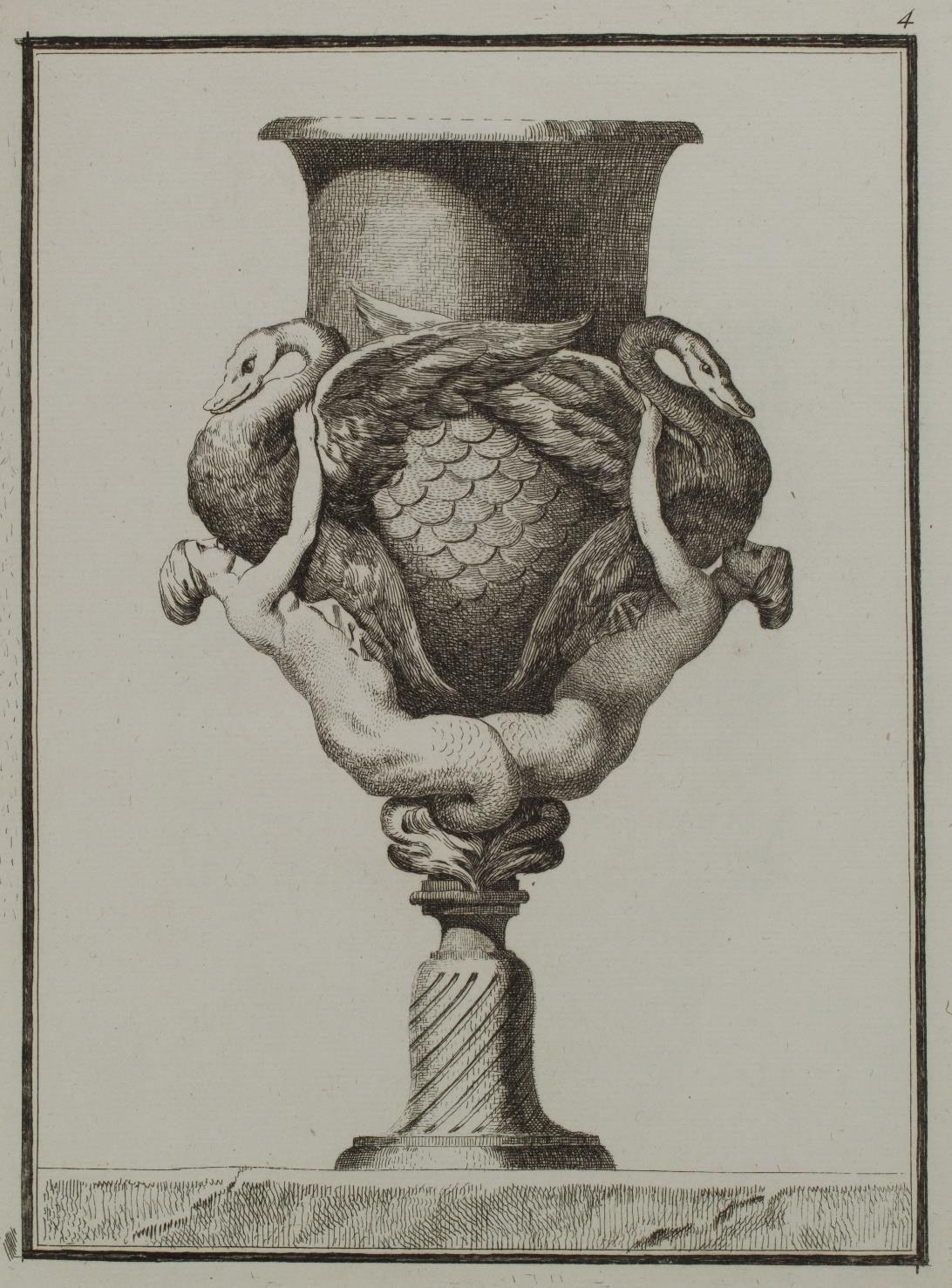

Gabriel HUQUIER (1695 - 1772)
Premier livre de vases inventés par Edme Bouchardon
Complete series of 12 plates including a title plate. Guilmard p. 161 (Bouchardon). Guilmard mentions “two series of 12 plates each” (our translation), but both our series (see the Second livre de vases below) are consistent with those at the INHA. Plates are numbered 1 to 12, number 1 is the title plate.
Gabriel HUQUIER (1695 - 1772)
Second livre de vases inventés par Edme Bouchardon

Complete series of 12 plates including a title plate. Guilmard p. 161 (Bouchardon).
F. BRARD (fl. in the 18th century)
Ie suite de vases par différends maitres
Complete series of 6 plates after Louis Doré. Guilmard p. 268 (Doré).
Another copy of this series, with the numbers, is bound in the first volume.
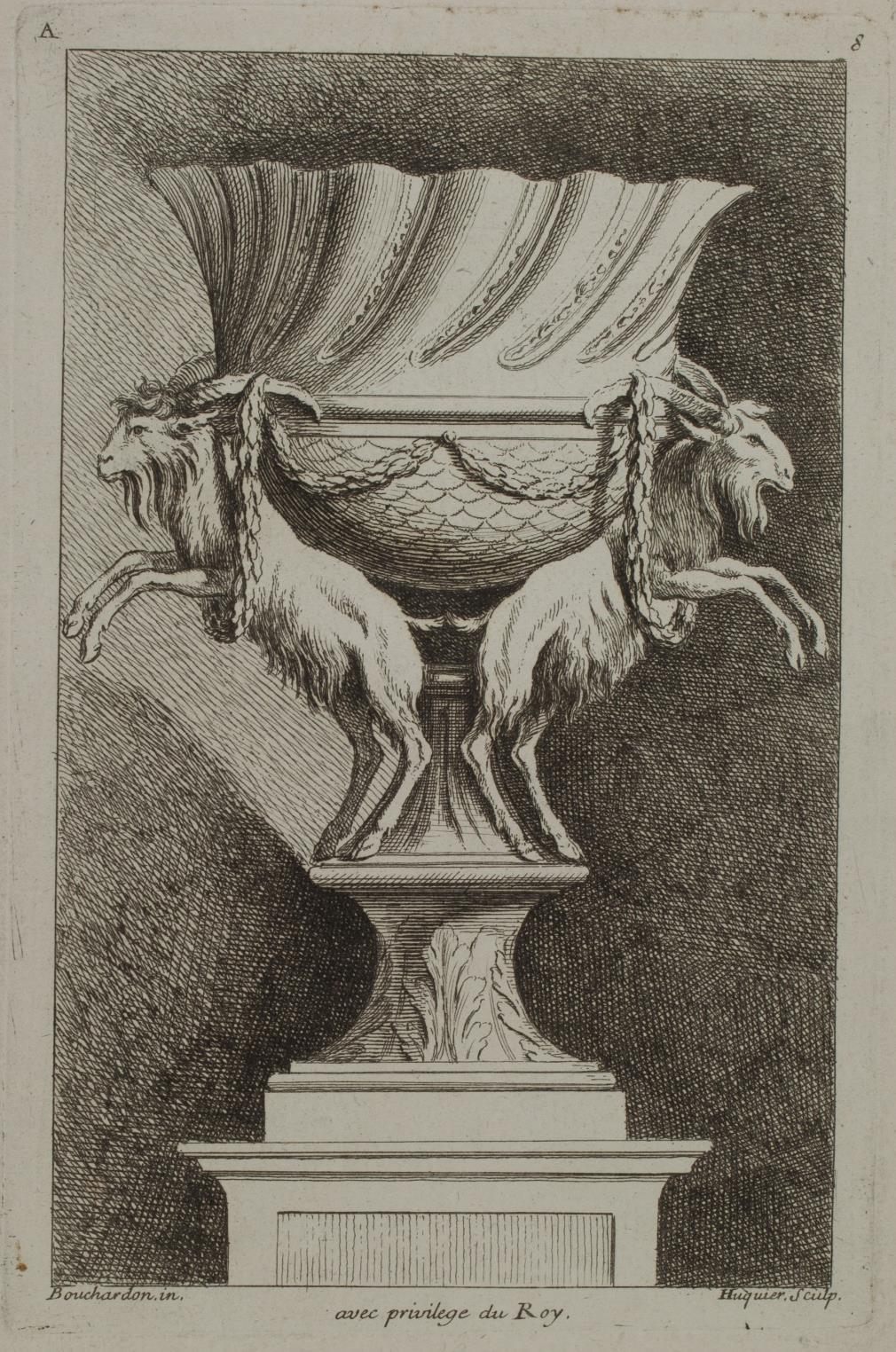

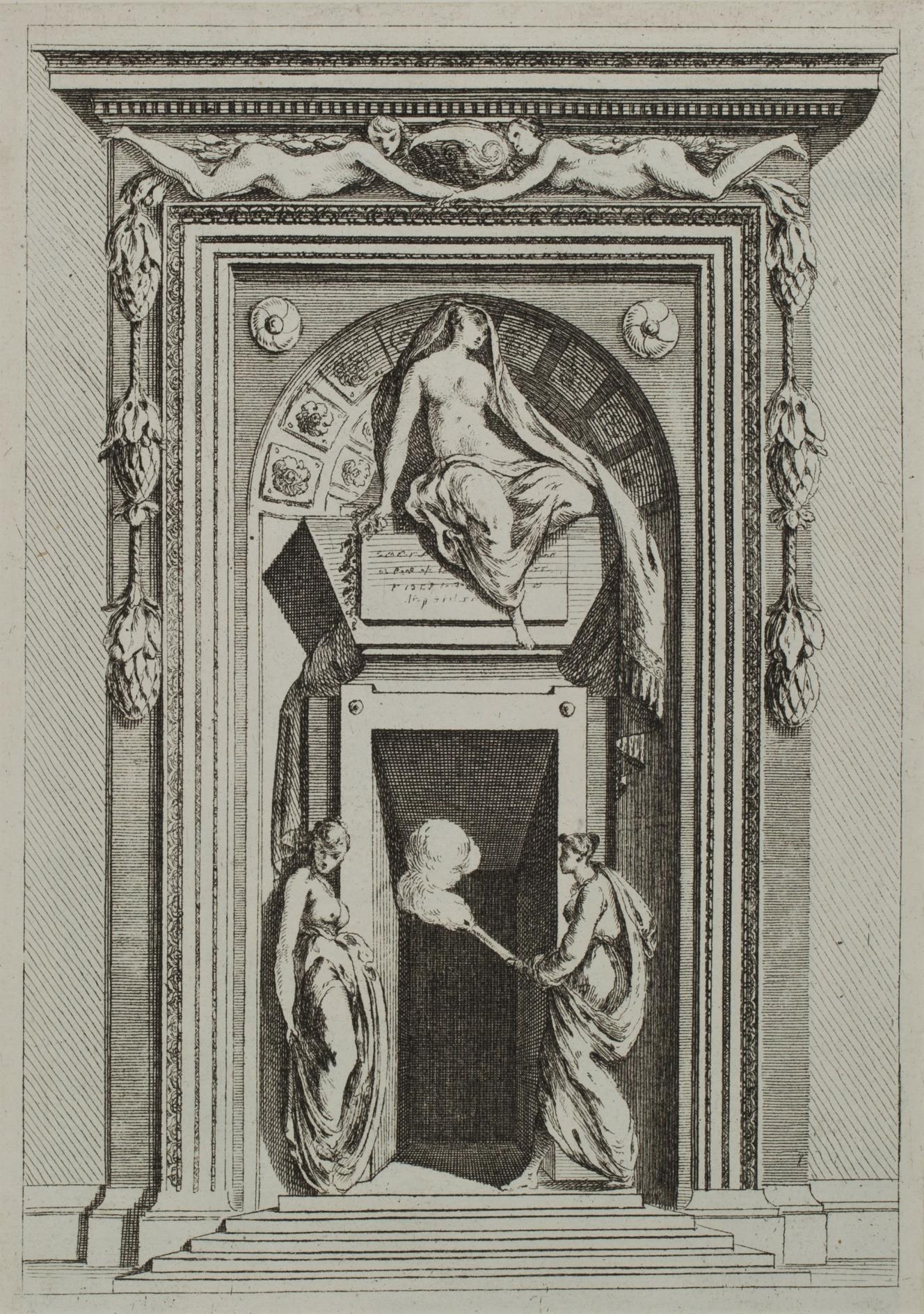

LIST OF THE PRINTMAKERS
Adélaïde ALLOU (fl. c. 1770)
Jean Jacques AVRIL known as AVRIL the Elder (1744 1831)
Stefano della BELLA (1610 1664)
Juste Nathan François BOUCHER known as BOUCHER fils (1736 1782)
René BOYVIN (c. 1525 1598 or 1625/6)
F. BRARD (fl. in the 18th century)
C. BRESSE (fl. c. 1760)
Charles Nicolas COCHIN I (1688 1754)
Joseph Abel COUTURE, known as COUTURE the Elder (fl. at the end of the 18th century)
Jacques DAMERY (1626 1685 ?)
Charles DUPUIS (fl. in the 18th century)
Jean HOUDAN (fl. c. 1775)
Gabriel HUQUIER (1695 1772)
Charles François JOLY (fl. in the 2nd part of the 18th century)
Jacques JUILLET (born in 1739)
Jean Laurent LE GEAY (1708 1790)
Jean LEPAUTRE (1618 1682)
MANIERE (fl. in the 18th century)
Pierre de MASSART, known as ROCHEFORT (c. 1673 1728)
Pierre MILAN (fl. between 1542 and 1557)
MOITHEY the Elder (fl. at the end of the 18th century) P. NICOLET (fl. in the 18th century)
Jean Louis PRIEUR (1732 1795) (attributed to)
RAUX (fl. c. 1758 1778)
Aegidius SADELER II (c. 1570 1629)
Claude-Henri WATELET (1718 - 1786)
References
Guilmard, Désiré : Les Maitres ornemanistes, 1881
Jong, Marijnke de, Irene de Groot (ed.) : Ornamentprenten in het Rijksprentenkabinet, 1988
Fuhring, Peter : “Ornament Prints in Amsterdam”, in Print Quarterly, September 1989, Vol. 6, No. 3, p. 322 334

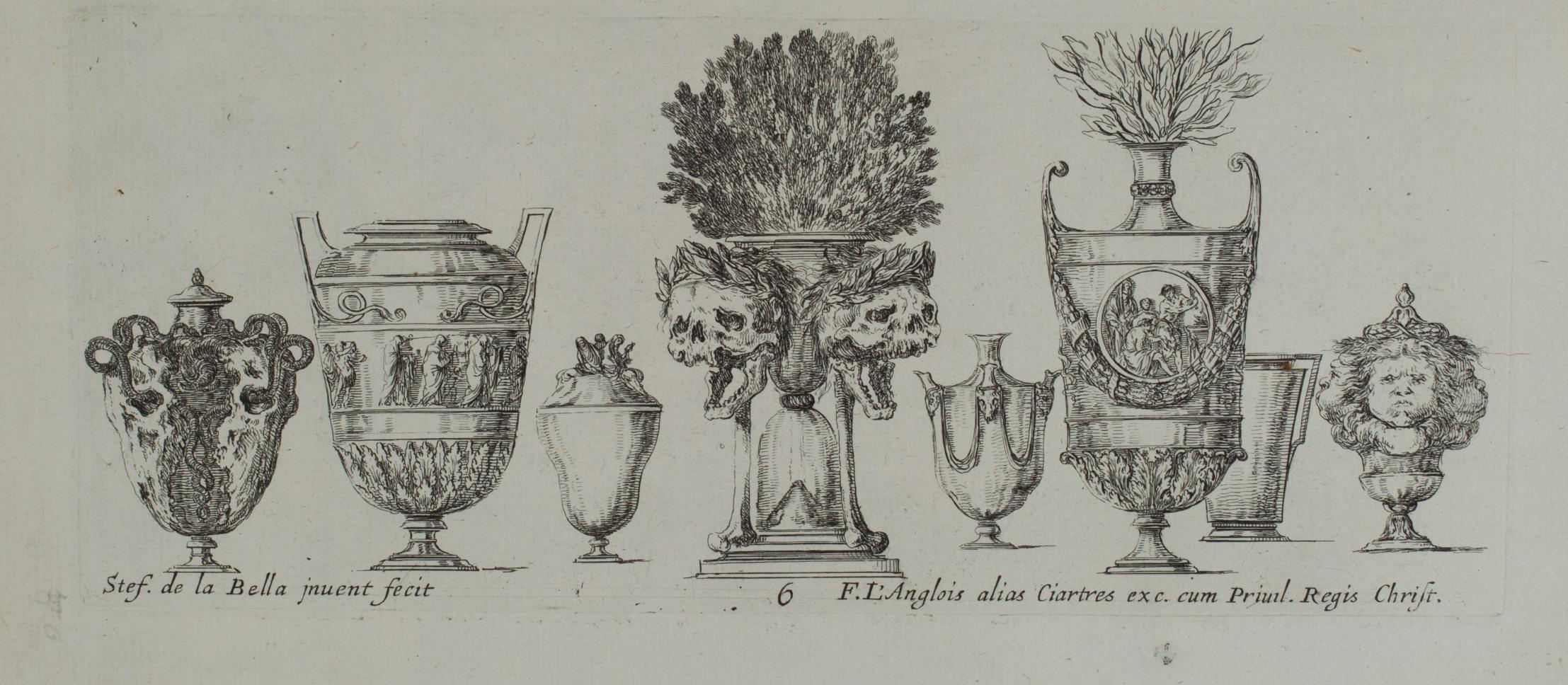
Stein,
Duplessis : Le peintre graveur français : ou catalogue raisonné des estampes gravées par les peintres et les dessinateurs de l’École française, 1835 1871
Perrin, Charlotte Guichard, Rena M. Hoisington, and Elizabeth M. Rudy : Artists and amateurs: etching in 18th century France, 2013 Robert Dumesnil, Alexandre Pierre François, and Georges
Inventaire du Fonds Français

Snodin, Michael, and Maurice Howard: Ornament: a social history since 1450, 1996.
Bury, Michael : The Print in Italy 1550 1620, 2001

Levron, Jacques : René Boyvin, graveur angevin du XVIe siècle : avec le catalogue de son oeuvre et la reproduction de 114 estampes, 1941.
Portrait d’Hyppolite Destailleur (p.7 ) : Frontispice (détail) du Catalogue des estampes de l’école française du XVIIIe siècle, imprimées en noir et en couleur, pièces historiques et scènes de mœurs, suites de costumes, portraits, œuvres de Charlet, Gavarni, Lami, Monnier, les Vernet, dessins, composant la collection de M. H. D. (Paris, Danlos et Delisle, et Jules Bouillon, 1890).
No. 15 October 2022 © Copyright
Sarah Sauvin
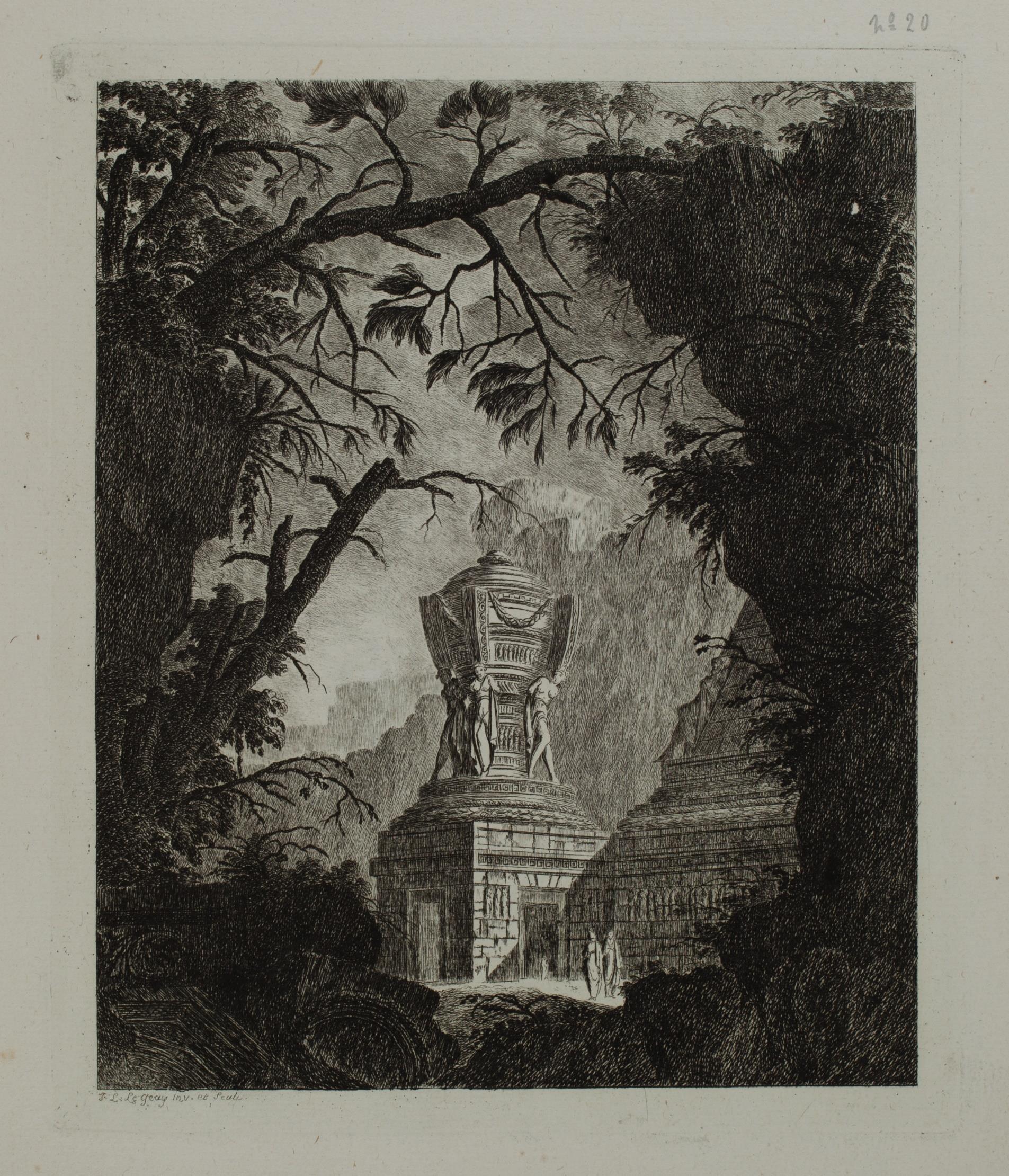


SARAH SAUVIN sarah-sauvin.com contact@sarah sauvin.com +33 (0) 6 24 48 33 64 By appointment in Paris International Fine Prints Dealers Association Comité national de l’Estampe, Paris Chambre Syndicale de l’Estampe, du Dessin et du Tableau, Paris SLAM & LILA

































































































































